FCS Multilog2 Multi Channel Data Logger
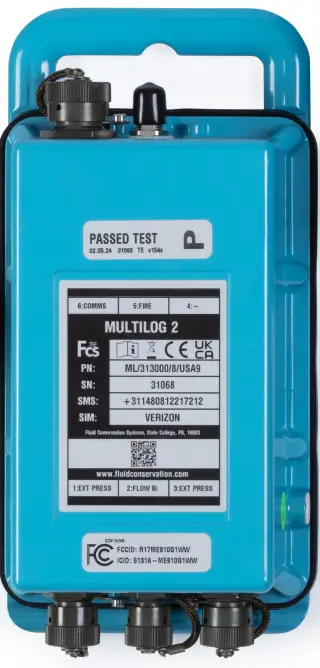
Fa'amatalaga
- Igoa o oloa: Multilog 2
- Ituaiga Meafaigaluega: Fa'amatalaga Logger
- Fa'ata'ita'iga Ufiufi: ML/*/*/* PT/*/*/* EL/*/*/* WL/*/*/*
- Fa'atusa Fa'aopoopo: WL series models for WITS systems
- Software Tool: IDT (Installation and Diagnostic Tool)
FOLASAGA
The “Multilog2” is a multi-purpose data logger device. Several models are available. Please contact your sales representative for help with selection of an appropriate model for your application.
HWM also provides a software tool, known as “IDT” (“Installation and Diagnostic Tool”) for logger setup and test. (See also section 1.6).
MODELS COVERED, DOCUMENTATION AND SUPPORT OF PRODUCT
O lenei ta'iala fa'aoga e aofia ai fa'ata'ita'iga nei:
Numera Fa'ata'ita'i Fa'amatalaga Masini
| Numera Fa'ata'ita'i | Fa'amatalaga o Meafaigaluega |
| ML/*/*/* | Multilog2 logger device. |
| PT/*/*/* | Pressure Transient2 logger device. |
| EL/*/*/* | Enhanced Network2 logger device. |
| WL/*/*/* | Multilog2 logger device (models for use in WITS systems).
– Additional information for WL series models can be found in the supplementary user guide. |
O lenei ta'iala fa'aoga e tatau ona faitau fa'atasi ma:
| Numera Pepa | Fa'amatalaga Pepa
Safety Warnings and Approvals Information (for Multilog2). IDT (PC version) user-guide. Multilog2 (Supplement for models supporting WITS protocol) IDT (app for mobile devices) user-guide. |
| MAN-147-0003 | |
| MAN-130-0017 | |
| MAN-147-0017 | |
| MAN-2000-0001 |
O lenei ta'iala fa'aoga o lo'o tu'uina atu ai fa'amatalaga o le fa'agaioiga logger ma pe fa'apefea ona fa'apipi'i le oloa. Va'ai fo'i i so'o se ta'iala fa'aoga po'o fa'amaumauga mo masini o lo'o fa'aogaina ma le logger.
Read the relevant parts of the IDT user-guide for guidance on how to confirm settings or modify the set-up of your logger. This includes:
- Auiliiliga o le setiina o alavai ma le faia o faamaumauga o faamatalaga.
- Fa'atonuga fa'amau mo le tu'uina atu o fa'amatalaga fua i se 'au'aunaga.
- Seti fa'amau mo fe'au fa'aopoopo, pei o fa'ailo.
Fa'aaliga: The system periodically has new features and changes released, thus you may observe slight changes from the diagrams and features shown in this manual. Installed features and functionality can vary from device to device, therefore always refer to the menus and screens of any setup tool to determine which features are available on your logger device.
HWM provides support for logger devices by means of our customer support webitulau: https://www.hwmglobal.com/help-and-downloads/
Afai ei ai ni au fesili e le o aofia i lenei tusi lesona poʻo le fesoasoani i luga ole laiga, faʻamolemole faʻafesoʻotaʻi le HWM Technical Support team ile +44 (0) 1633 489479, pe imeli cservice@hwm-water.com
MAFAUFAGA I LE SAOGALEMU
Before continuing, carefully read and follow the information in the “Safety Warnings and Approvals Information” document supplied with the product. This provides general safety information.
Taofi uma pepa mo fa'amatalaga i le lumana'i.
Before using this product, make a risk assessment of the installation site and expected work activity. Ensure suitable protective clothing is worn and working practises are followed during installation and any maintenance.
LAPATAIGA: Pe a fa'aogaina, fa'apipi'i, fetu'una'i, po'o le tautuaina, e tatau ona fa'atino e tagata faigaluega fa'apitoa e masani i le fausiaina ma le fa'agaioia o masini ma lamatiaga o so'o se feso'otaiga fa'aoga.
MAMALIGA FA'AGA
Va'ai ile Pepa Fa'amatalaga logger po'o lou sui fa'atau mo ta'iala ile teuina ma le fa'aogaina ole vevela ole masini. Ia fa'amautinoa o lo'o i totonu ole vaega ole vevela ole fa'aogaina a'o le'i fa'apipi'i po'o le fa'atulagaina.
USE OF CELLULAR NETWORKS – IMPORTANT NOTES
Avanoa o SMS
Most Multilog2 models include the ability to communicate to a server via use of the cellular data network. This is usually via the regular data network (which gives internet access). Alternatively, the SMS (Short Message Service) messaging can be used; in most cases this will be as a fall-back if the logger is temporarily unable to access the regular data network. If configured for SMS use, the logger uses the available 2G network.
Taua: 2G (GPRS) services, which carry the SMS messaging system, are slowly being turned off around the globe. Once 2G is switched off, the SMS services available within the logger will no longer be able to function. Unless deactivated in the logger settings, the logger will continue to try, wasting battery power. Therefore, check with your cellular network operator for their switch off date before setting the logger to use the SMS backup service or any other feature requiring SMS use.
To deactivate the use of the SMS system, any related SMS settings must be removed (switched off or deleted). Refer to the IDT User Guide for details of SMS settings.
Any modified settings must be saved to the logger.
Fa'aaliga: For use of SMS services, both the logger and the cellular network provider must support SMS. In addition, the SIM card fitted inside the logger must support SMS use. (Check with your SIM supplier if required).
Logger faʻamatalaga pe a faʻaaoga SMS
A fa'aogaina le feso'ota'iga telefoni feavea'i, o le fa'asinomaga logger e aofia ai ma fa'amaumauga i totonu o le fe'au. Ae ui i lea, pe a faʻaaogaina le SMS, o le faʻamatalaga o le numera telefoni (mai le SIM card). O le mea lea, pe a faʻaaogaina soʻo se SMS, o nei numera e lua (faʻatulagaina IDT o le numera telefoni ma le numera telefoni SIM) e tatau ona fetaui.
VIEWI FA'AMATALAGA
I view logger data mamao, a viewmeafaigaluega (website) o loʻo faʻaaogaina. Eseese webo lo'o avanoa nofoaga. Ta'itasi web'upega tafa'ilagi o lo'o tu'uina atu fa'amatalaga e feso'ota'i ma nofoaga fa'apipi'i logger. Le filifiliga o web'upega tafa'ilagi o le a fa'alagolago i le ituaiga masini fa'aoga ma latou fa'aoga.
E mafai fo'i ona iai fa'amatalaga mai lau logger viewed fa'alotoifale fa'aoga IDT ile taimi ole asiasiga ile nofoaga.
Va'ai i mea tau a'oa'oga o lo'o avanoa mo oe viewing tool and also the IDT user-guide for further information.
IDT – SOFTWARE TOOL (FOR LOGGER PROGRAMMING AND TESTS)
O se meafaigaluega faakomepiuta, ua ta'ua o le “IDT” (Installation and Diagnostic Tool), o lo'o avanoa mo le siakiina po'o le faia o fetuunaiga i le seti logger ma fa'apea fo'i mo le su'eina o le galuega logger i luga o le saite.
Choosing which version to use
The IDT software tool provides a user-interface to the logger. It can be used for checking or making adjustments to the logger settings and for testing the logger operation within its installed site. Prior to IDT being able to perform these functions, it has to ‘connect to’ the logger; this simply means that the two end devices (logger software and IDT software) are able to communicate with each other over a working communications path.
IDT is available in three versions:
- IDT for PCs having a Windows-operating system.
- IDT for mobile devices (phones and tablets) having an Android operating system.
- IDT for mobile devices (phones and tablets) having an (Apple) iOS system.
The latter two are referred to as the ‘IDT app’, whereas the first is referred to as ‘IDT (PC)’ or ‘IDT (Windows)’.
It is recommended to install and use the IDT app version whenever possible; it covers most types of HWM loggers. There are, however, a small number of situations where loggers or logger/sensor combinations that (at the time of writing) require the use of the IDT (PC) tool. Refer to section 8 for further details of which sensors or features require IDT (PC), as applicable to the loggers listed in section 1.1.
IDT (PC VERSION)
Va'ai ile IDT (PC version) User-Guide (MAN-130-0017) mo fa'amatalaga i le auala e saunia ai lau PC mo le feso'ota'i ma le logger. O lo'o tu'uina mai fo'i e le ta'iala fa'aoga fa'amatalaga pe fa'apefea ona fa'aogaina le IDT fa'atasi ai ma fa'atulagaga logger eseese.
IDT APP (MOBILE DEVICE VERSION)
Refer to the IDT app User-Guide (MAN-2000-0001) for details of how to prepare your mobile device (Android-based Tablet) for communicating with the logger. The user-guide also gives details of how to use the IDT app with various logger settings.
UMAVIEW
LOGGER DEVICE OVERVIEW
VAEGA FAALETINO & FA'AALIGA SOSE
The Multilog2 logger family is flexible in design and can be built to suit a variety of uses. It has a metal enclosure and is of a waterproof construction, using a seal to keep out water.
O se tasiample fa'aalia i le Ata 1.
The logger is powered by a non-rechargeable Lithium battery. The life of the battery can vary with its orientation; refer to Figure 1 for the orientation that will give best battery life.
The top of the logger includes a handle, used for carrying the unit. It also provides a convenient way of hanging the unit in its correct orientation using wall-mounted brackets or other fixing methods.
O lo'o iai fa'ailoga eseese i luga o le logger. E aofia ai:
- The nameplate label, which includes the logger part-number, its serial number, and an ‘SMS number’ (an identifier for the logger, in the form of a telephone number).
- Fa'ailoga fa'amatalaga fa'afeso'ota'i.
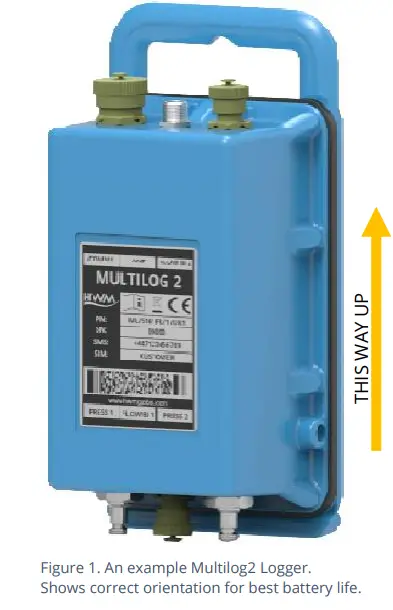
The logger has waterproof electrical connectors for attaching sensors and the antenna. These can be present on two surfaces (top and bottom). The interfaces installed, and their position, will vary between model-number supplied. Follow the labels to identify interfaces.
A pressure interface may also employ a built-in pressure transducer with a quick-release connector. This is for direct connection to a pipe (or hose).
MA'A I FAFO (FILIFILI)
Most Multilog2 models have a connector that allows an External Battery to be connected. These provide the logger with additional power capacity.
O se tasiample fa'aalia i le Ata 2.
E avanoa ma'a eseese.
Always use HWM supplied batteries to ensure compatibility and safety. Ensure the cable supplied with the battery is suitable for the external power connector fitted to your logger. (6-pin and 10-pin connector versions are available. See also section 2.7).
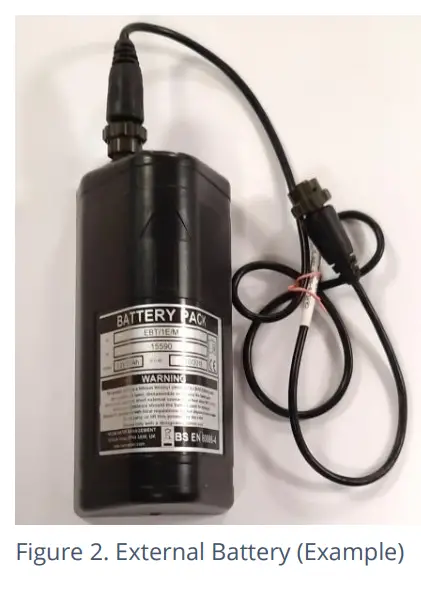
(For situations where the use of an external battery is required, seek the advice of your HWM representative).
LOGGER GALUEGA
- The logger software is designed to minimize battery use and thereby prolong the expected battery life. However, battery life is also affected by user-programmablesettings. The user is advised to set the logger tasks and sample alaleo i tulaga aupito maualalo o le faaaogaina faamoemoeina ina ia pulea lelei le malosi maa.
- Pe a tu'uina atu, e fa'aaoga le malosiaga o le maa i fafo e fa'alautele ai le ola o le maa o le logger po'o le fa'ataga o feso'ota'iga fa'atele ma le 'au'aunaga talimalo.
- O le logger e masani lava ona lafo mai le falegaosimea i se tulaga le toaga (fa'asino i le
'tulaga uta', po'o le 'tulaga moe') e fa'asaoina ai le ola o le maa. - When activated (see section 3), the logger will initially go into the state of “Waiting” (for a short time). Then it will go into the state of “Recording” and begin repetitive logging of measurements from the various sensors fitted to the unit, according to its configuration and settings.
- O lo'o fa'agaoioia le logger e fa'aaoga ai taimi e lua, ua ta'ua o le “sample vaitaimi” ma le “vaitaimi o faamaumauga”. O le a sample masini i le sample fua faatatau e faia fua le tumau samples; ose galuega tala'i fai soo. Ina ua uma ona faia ni fua sample mea, o nisi o galuega fa'afuainumera e mafai ona fa'aoga filifiliga e maua ai se fa'amaumauga o lo'o fa'amauina (fa'asaoina) i le fua fa'atatau; o nei mea e fai ai fua fa'amaumauina ma fa'asaoina i totonu o se vaega e manatua ai e ta'ua o le "fa'amaumauga muamua". Ole taimi ole ogalaau e masani lava ole fa'atele ole sample vaitaimi.
- Afai e mafai e le logger ona fa'aogaina le fa'aaliga, e mafai fo'i ona fa'atulaga e fa'asaoina fa'amatalaga fa'aopoopo i nisi taimi i totonu o se vaega e manatua ai le "fa'amaumauga lona lua" (silasila i le vaega 2.4), (fa'ata'ita'iga, fa'amaumauga s.amptaʻitaʻia i se taimi maualuga, e pei o le faʻaaogaina o le "sample vaitaimi" nai lo le "vaiota ogalaau").
Manatua: E le maua lenei mea i luga o iunite uma e tuʻuina atu ma e tatau ona faʻatulagaina e ala i lau sui faʻatau aʻo leʻi tuʻuina se poloaiga; o lo'o iai a'afiaga e fa'atatau i le fa'amoemoeina o le ola maa o le iunite.
The logger will also have daily tasks at set times, such as uploading its unsent data over the internet. When sending data, the logger waits to receive confirmation from the server that the data was received without error; If confirmation is not received, it will re-send the data at the next call-in time.
O le logger e mafai ona faʻapipiʻiina e mataʻituina faʻamaumauga mo nisi faʻasologa poʻo tulaga ma e mafai ona lafo se feʻau pe a tatau ona iloa se fetaui. E masani lava, o lenei mea e faʻaaogaina mo le faʻatulagaina o se tulaga e mafai ona avea ma faʻailoga o se "talatala". E mafai ona lafo le fe'au i le 'au'aunaga (le nofoaga masani) po'o se isi masini.
FA'AVAE LE LOGIG (FILIFILI)
Section 2.3 gave a description of logger operation that is available as standard on most Multilog2 logger models; The logger normally samples fa'amaumauga i le seti sample vaitaimi, ma fa'amaumau fa'amaumauga i le taimi fa'atulagaina o fa'amaumauga. Ae ui i lea, o nisi o faʻataʻitaʻiga e ofoina atu filifiliga mo le faia o faʻamaumauga faaopoopo (o faʻamaumauga faʻamaumauga) i luga atu-nai lo masani sampfua faatatau. O fa'amatalaga fa'aopoopo o lo'o fa'amauina i totonu o le vaega e manatua ai le "fa'amaumauga lona lua".
These features are sometimes referred to as “Enhanced Network” logging and “Pressure Transient” logging; Collectively they are referred to as “Fast Logging”. The ‘Enhanced Network’ and ‘Pressure Transient’ loggers (both being based on the Multilog2 design), have the named option available as standard.
Fa'aaliga: The feature can only be installed by the factory at the time of build. The options must therefore be specified at the time of ordering, along with the required maximum sampfua faatatau ling.
Faaopoopo sampling e iai a'afiaga mo le fa'aogaina o le eletise ma e ono mana'omia le fa'aogaina o ma'a fafo e fa'amalieina ai le ola tautua mana'omia.
E mafai ona fa'aletonu le fa'apipi'iina o fa'ailoga o le logger i le taimi o le setiina o le logger. Afai e mafai, e lua ta'iala a le logger mo le taulimaina o le manatua ua tumu. Po'o le fa'ato'a fa'amuta vave, po'o fa'amaumauga tuai e mafai ona fa'amaualuga. Fai le filifiliga e te manaʻomia i le taimi o le seti.
E le mafai ona galue uma ituaiga masini i s maualugaampling frequency. O le mea lea e masani ona setiina le ata e galue i masini faʻatusa, e pei o se faʻaliliuga mamafa.
E masani ona fa'aogaina le fa'ato'aga vave e mata'ituina ai suiga o le mamafa i luga o feso'ota'iga vai.
For Multilog2, ‘Enhanced Network’ logging and ‘Pressure Transient’ logging are mutually exclusive settings (only one can be used). Each has a different operation.
Fa'aleleia le fa'amauina o feso'ota'iga:
- O lenei filifiliga e mafai ai e nisi mea tutupu ona fatuina se pu'ega lona lua.
- O le pueina o le a faia i tua sampfua faatatau ling.
- O le pueina e mafai ona avea ma se tasi auala pe mafai foi ona aofia ai isi auala (pe a mafai e le masini ona taulimaina le saoasaoa).
- Le maualuga sampe fa'atapula'a le sao o le ling i le fa'atele ole 1Hz.
O'omiga Tumau Tatala:
- O lenei filifiliga e mafai ai e nisi mea tutupu ona fatuina se pu'ega lona lua.
The logger has additional memory due to the amount of data required to be stored. - O le pueina o le a faia i leampling rate of 1Hz or one of a selection of higher frequencies, up to 25Hz.
- On Multilog2, up to two channels can be used. Each of these must be for a pressure sensor. The sensors must be allocated to channel 1, or channels 1 & 2.
E mafai ona fa'atulaga ia fa'amaumauga e tupu i taimi fa'apitoa po'o le tali atu i fa'alavelave fa'afuase'i eseese po'o se suiga i se Tulaga Tulaga (fa'atusa, fa'aosoina e se suiga o mea mai masini fafo).
FA'ATAUINA FA'ATAUINA – TE'U MA VIEWI FA'AMATALAGA
The Multilog2 logger includes an interface (referred to as a modem) that provides access to the internet via the cellular mobile communications network. A SIM card is used to give access of the network.
O fa'amaumauga o fua e teu muamua i totonu o le logger, se'ia o'o i le isi taimi e vala'au ai. O fa'amaumauga e mafai ona tu'uina atu i le 'au'aunaga e fa'aaoga ai se fa'ailoga fa'ailoga. E masani lava, o le 'auʻaunaga na faʻaaogaina e maua ma teuina faʻamaumauga o le a avea ma HWM DataG'ai le server, e ui lava e mafai ona fa'aogaina isi 'au'aunaga fa'atasi ma le HWM software.
O faʻamatalaga logger atonu e viewed fa'aaoga a viewi totonu o le faitotoa lea e mafai ona maua ai faʻamatalaga o loʻo teuina i luga o le server. (Silasila i le ta'iala fa'aoga talafeagai mo fa'amatalaga o au fa'amatalaga viewe mafai ona faʻaaogaina view o faʻamatalaga logger).
Fa'aaliga: Multilog2 loggers supporting WITS protocol behave differently to the above.
These loggers do not use DataGate but communicate with a WITS Master Station. The data can be viewed only by use of the WITS system.
DATAGATE SERVER / DATA VIEWPORTALS
Pe a tuʻufaʻatasia ma le HWM's DataG'ai le server, e mafai ona teuina fa'amaumauga a le logger i totonu ma fa'aavanoa mo tagata fa'aoga e ala i a viewfaitotoa (webnofoaga). E mafai e le 'auʻaunaga teuina faʻamaumauga ona faʻatautaia le mauaina ma le teuina o faʻamaumauga mai se iunite e tasi, pe mai se vaʻa atoa o le au loggers.
Viewi Faamaumauga a le Peraimeri:
O fa'amatalaga mai lau logger(s) e mafai viewed remotely / graphically by anyone authorized to do so, with a suitable user account (and password) using a standard web-su'esu'e.
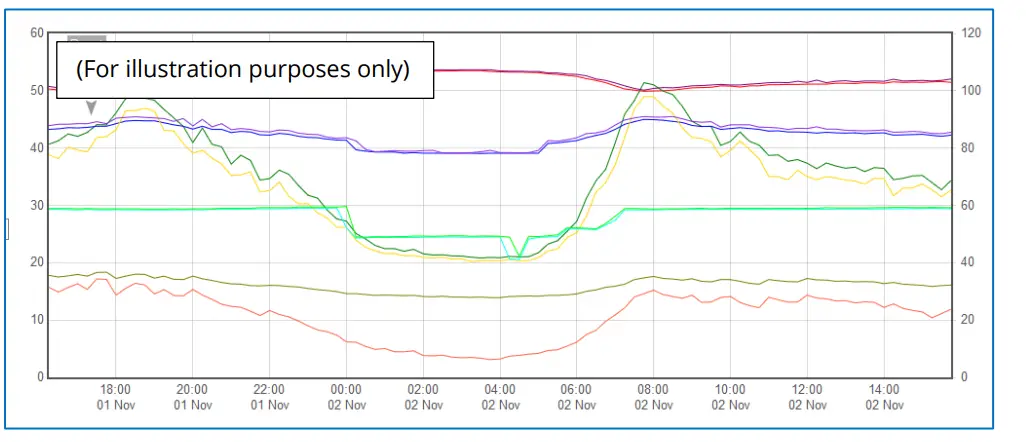
E iai le filifiliga a le HWM webnofoaga e mafai ona fa'aoga i ai view fa'amaumauga logger. Le filifiliga sili o webe fa'alagolago le nofoaga ile ituaiga masini e fa'aoga ile logger.
A web'upega tafaʻilagi ma faʻamatalaga lautele viewer can show data graphically, but only for one logger at a time, installed on one site.
A web'upega tafa'ilagi e mafai ona fa'aalia ai le va'a o le au logger, e tofu le tagata ma le ituaiga o masini, e masani ona mafai ona tu'uina atu fa'amatalaga i se auala e sili atu ona anoa i le tagata fa'aoga, fa'atasi ai ma fa'amatalaga fa'aopoopo aoga (fa'ata'ita'iga, o se fa'afanua o lo'o fa'aalia ai nofoaga o lo'o tu'u ai mea). O lea la, a web'upega tafa'ilagi e mafai ona tu'uina atu se ata o le tulaga o iai nei o le tele o saite i le taimi e tasi.
Va'ai i le IDT user guide po'o le sensor user-guide mo fa'amatalaga viewe sili ona talafeagai le fa'aoga. I le isi itu, ia talanoaina lenei mataupu ma lou sui HWM.
O le DataGe mafai fo'i e le 'au'au ona tu'uina atu so'o se fa'ailo na maua mai le logger i tagata uma na fa'aigoaina; o lea e mafai ona tufa atu i le tele o DataG'ai tagata fa'aoga.
DataG'ai e mafai foi (e ala i le faʻatulagaina ma lou sui faʻatau) faʻaaoga e auina atu ai faʻamatalaga logger i isi servers.
O nisi fa'atonuga fa'atonu a le 'au'aunaga ma le viewe masani ona mana'omia le faitoto'a e faafaigofie ai le mauaina, teuina, ma le tu'uina atu sa'o o fa'amaumauga a le logger. (Faʻatulagaina ma le faʻaaogaina o le DataGate system (po'o so'o se isi lava server) e le o aofia i lenei ta'iala fa'aoga).
Viewi Fa'amaumauga Lua:
Mo 'upega tafa'ilagi o lo'o iai fa'ata'ita'iga logger fa'atasi ai ma le fa'apipi'i vave, atonu na faia fa'amaumauga lona lua. O lo'o teuina fo'i i luga o le 'au'aunaga.
O au fa'amatalaga viewer will have a means of displaying secondary recordings.
It may, for example, fa'aali se fa'ailoga i luga o le fa'asologa autu e fa'ailoa ai le tulaga o lo'o maua ai fa'amatalaga vave (fa'ata'ita'iga, le mea na tupu ai se mea le tumau). Kiliki le fa'ailoga e tu'u mai ai se va'aiga view o le tumau.
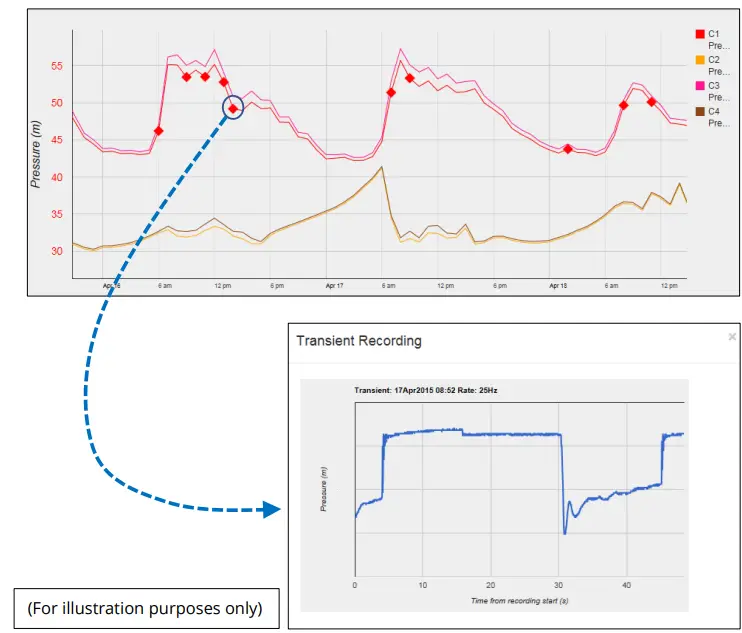
Viewing location fix (GPS track):
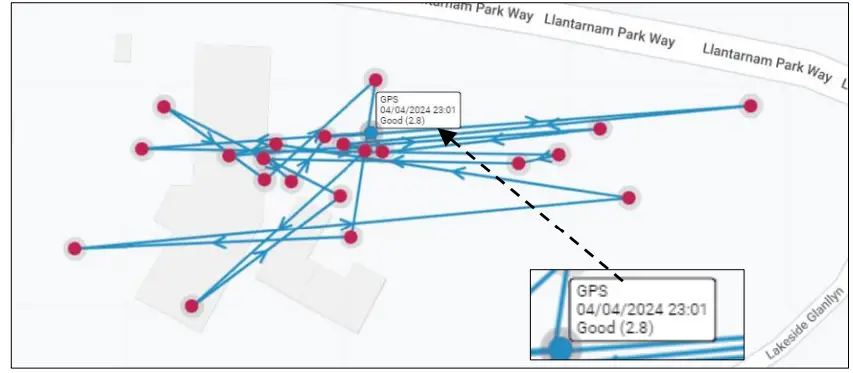
For logger models that include GPS position fix capability, the server will provide a facility to track the location history of the logger. Details of the GPS location fix can be found, typically by selecting one of the shown points. The quality of the location fix will be shown as a number. (This is known as a DOP value. Refer to the table below).
| Taua | Vasega | Fa'amatalaga |
| <2 | Lelei
/ ideal |
Excellent confidence in location fix accuracy. |
| 2-5 | Lelei | Good confidence in location accuracy / reliable result. |
| 5-10 | feololo | Moderate confidence in location accuracy. A more open view of the sky or acquisition period may improve. |
| 10-20 | Talafeagai | Low confidence level in location accuracy. Indicates a very rough estimate of location. |
| >20 | Mativa | Poor confidence of accuracy of location. The measurement should be discarded. |
TUSI FAʻAMATALAGA
O mea fa'aoga (antenna ma puipui mo le fa'apipi'iina o le iunite) o lo'o avanoa e fetaui ma tulaga fa'apipi'i eseese; talanoa avanoa ma lou sui HWM.
COMMUNICATIONS INTERFACES AND PROGRAMMING CABLES
To communicate with the Multilog2 logger, a programming cable is required. There are two connector options available in the logger family for making this connection (10-pin or 6-pin); only one of these alternatives will be fitted. Use a programming cable that matches the connector type on the logger.
On Multilog2, the connectors used for communications are frequently shared; they also include the connections required for fitting an external battery (see section 2.2). Because of space limitations, the label may not indicate this (e.g., It may simply be labeled “COMMS”).
A typical connector used for communications and its matching communications cable is shown in Figure 3.
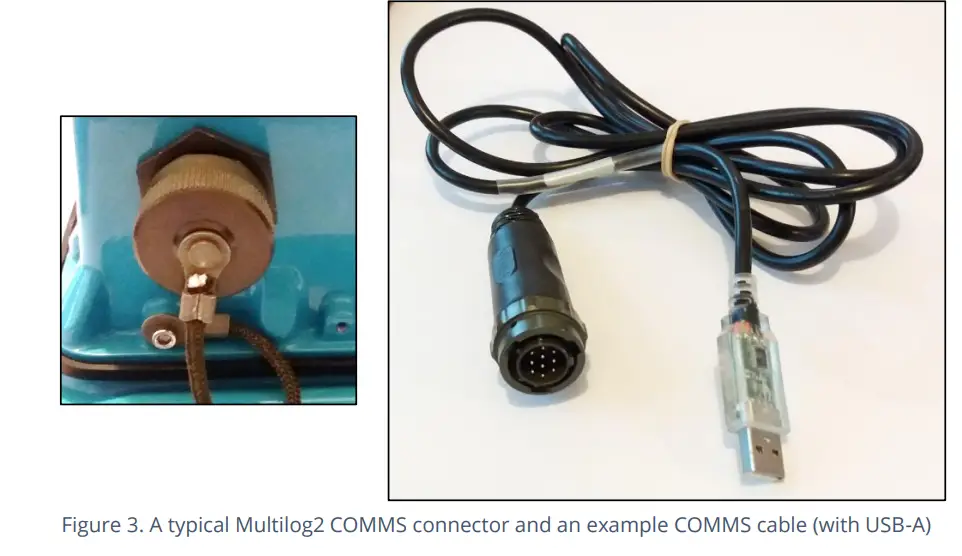
The connector of the communications cable will only include the pins required for communications purposes.
To use the communications cable, temporarily remove any existing connector, and re-connect it when finished. Alternatively, an adaptor (Y-cable) can be inserted to be able to support the logger using both functions together.
Attach the Comms cable to the logger, and then complete the connection to the IDT host using one of the methods described in section 2.8.
Examples of suitable programming cables are given below:
- 10-pin : COM AEUSB (USB to RS232 comms cable).
- CABA2075 (direct USB comms cable).
- 6-pin : CABA8585 (direct USB comms cable).
COMPLETING THE COMMUNICATIONS PATH
For IDT to communicate with the logger, first select the appropriate cable and connect it to the COMMS connector of the logger, as described in section 2.7. The USB-A end of the programming cable should be used to connect to the IDT host by using one of the following methods:
IDT – USED WITH A PC (& WINDOWS).
Prior to use, the PC should have the IDT (PC version) programming tool installed.
The USB-A end should be plugged directly into a USB-A port of the PC (or to USB-B or USB-C port via a suitable adaptor). Refer to Figure 4.
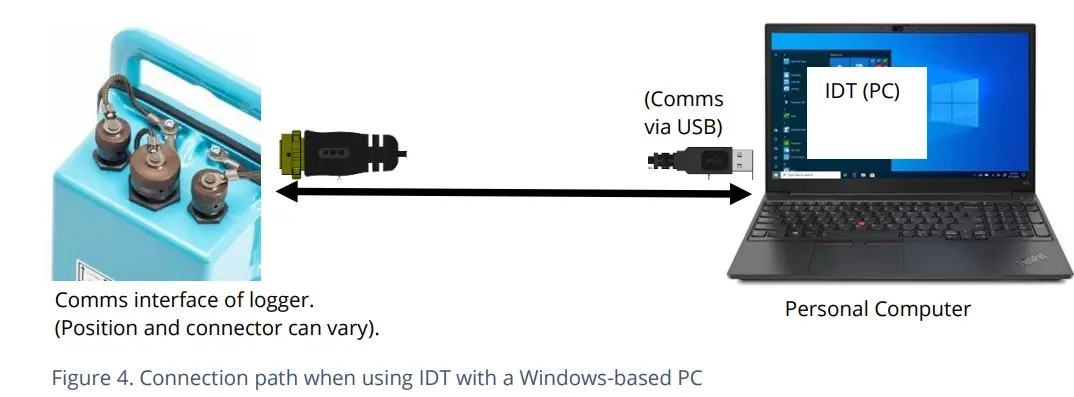
IDT APP – USED WITH A TABLET (ANDROID) / USB OPTION
Certain Android-based Tablet devices (which must have an available USB port) are able to use this method. (For latest information about known compatible devices, contact your HWM representative).
Prior to use, the mobile device should have the IDT app software installed.
The USB-A end should be plugged directly into a USB-A port of the tablet (or to a USB-B or USB-C port via a suitable adaptor). Refer to Figure 5.
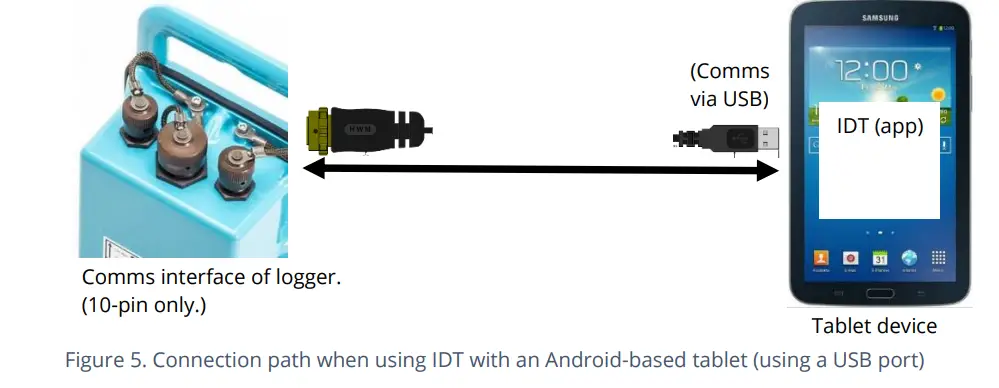
This connection method is only compatible with a 10-pin logger connector and using the COM AEUSEB (USB to RS232) comms cable, or CABA2080 (USB to RS232) Y-Cable.
IDT APP – USED WITH A MOBILE PHONE OR TABLET / BLUETOOTH OPTION
Certain mobile phone or tablet devices (which must be Android or iOS-based and support Bluetooth radio) are able to use this method. (For latest information about known compatible devices, contact your HWM representative).
Prior to use, the mobile device should have the IDT app software installed.
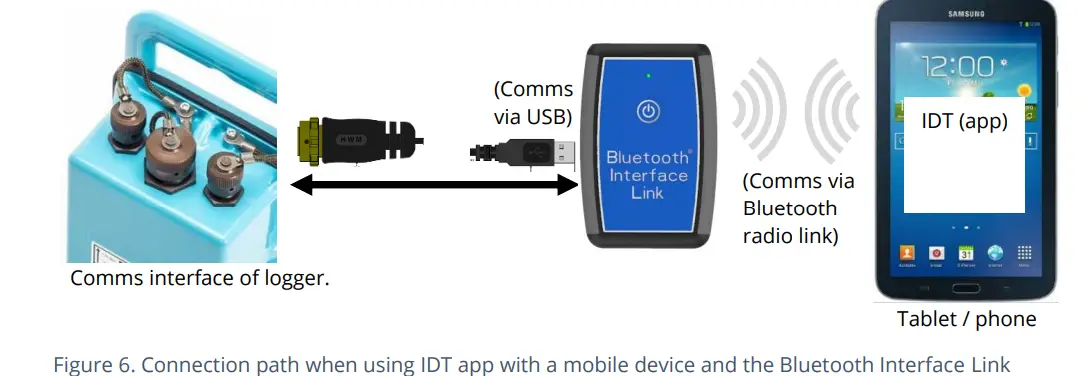
The connection path (refer to Figure 6) makes use of a communications adapter known as the HWM ‘Bluetooth Interface Link’. Connect the logger end of the communications cable to the logger. Then the USB-A end of the communications cable should be plugged into the USB-A port of the Bluetooth Interface Link unit. The device should be turned on during use. The IDT app is required to be paired to the Bluetooth Interface Link unit prior to communication with the logger. The Bluetooth Interface Link handles protocol translations and flow control of messages between the logger
(via the comms cable) and the radio link.
FA'AGAINA O LE LOGGER MA FESOOTA'IGA
The communications interface is always monitored for activity and the logger will usually respond, unless it is busy communicating to the cellular network.
GALUEGA FA'AGA LOGGER (MO LE FA'A'OGA MUAMUA)
Pe a lafo mai le falegaosimea, o le iunite o loʻo i totonu o le 'faiga faʻatau' (faʻateʻaina; e le saini pe valaʻau i totonu). O lenei faiga e talafeagai mo felauaiga poʻo le teuina umi. Ina ia faʻaaogaina le logger, e tatau ona faʻagaoioia muamua.
The process for doing this depends upon the logger setting for logging re-activation. Various setting options are available (specified time, upon connection of an external battery, upon the activation of a magnetic switch, ‘immediately’).
Most loggers are set to start ‘immediately’ upon having their settings read by IDT and then saved back to the unit.
Once activated, the logger will initially go into the state of ‘Waiting’ (for a short time). Then it will enter a status of ‘recording’, where it is executing its repetitive logging functions.
The method depends on which version of IDT is being used:
- For IDT (PC), the user can do this manually (even if no program changes are required). (Refer to the IDT user-guide for the steps required to read the logger program and then to save it back to the unit using the ‘Setup Device’ button).
- For the IDT app, the user can also do this manually via a Start Device’ button. In addition, the app will check for potential issues whenever the user makes a controlled disconnection of the logger from the app, including a check for a logger that is not yet activated / recording.
Before leaving site, check that the logger has been correctly set up for logging, call-in tasks and that it is in a state of ‘Recording’ (logging). Refer to the IDT user-guide for guidance on how to check these points.
INTERFACES AND SENSOR TYPES (SUMMARY)
Fa'aaliga: Lagolago mo feso'ota'iga po'o galuega fa'apitoa e eseese ma e fa'alagolago i le fa'ata'ita'iga na tu'uina atu.
Sensors e maua ai faʻamatalaga mo vaega faʻaletino eseese, ma o nei faʻamatalaga e tuʻuina atu i le logger e ala i se fesoʻotaʻiga eletise talafeagai.
O feso'ota'iga ta'itasi o lo'o iai fa'asologa o le logger mo le amataina o le fua fa'apea fo'i le fa'auiga sa'o o fa'amaumauga numera na maua. O lo'o fa'aogaina le IDT e fa'atautaia ai fa'atulagaga.
Wired connections are made to the logger via a connector mounted through the logger case. Various sizes are available and can contain either pins or sockets. Some examples are shown in Figure 9 and Figure 8. A dust-cap is available as an option to keep unused connectors free of water and debris (see Figure 7).
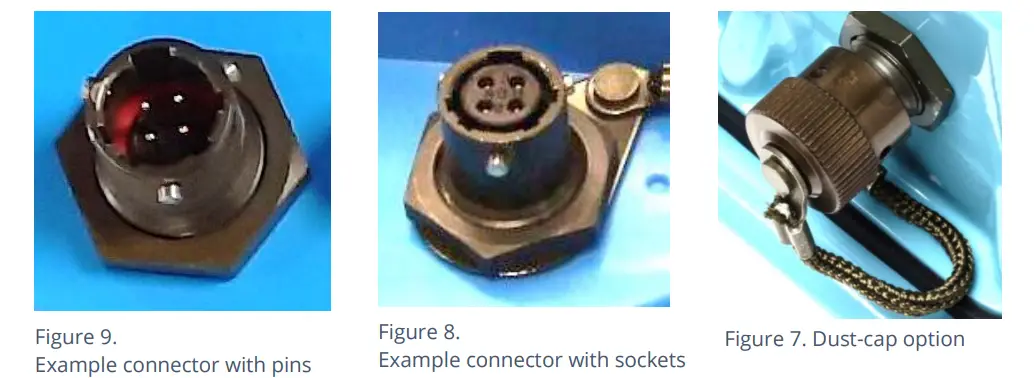
Some connectors are single-purpose in nature (e.g., For connection of a single sensor). However, other connectors may be multi-purpose (e.g., Having both a connection for a programming cable and also for the supply of power from an additional battery).
Where a connector is multi-purpose, a Y-adapter cable may be required to split out the various functions.
For water pressure measurement, the electrical connection to the sensor may be made via a standard electrical connector. This interface is known as an “External Pressure” type. It allows a cabled pressure transducer (sensor) to be connected to the logger. HWM can provide a variety of cabled pressure sensors with the appropriate connector for the logger.
An alternative for water pressure measurement is for the transducer (sensor) to be built into the unit, as shown in Figure 10. This logger interface is known as an “Internal Pressure” type. It allows pressurized water to be connected to the logger directly, via the use of hoses fitted with a quick-release connector.
Mo antenna, e fa'aaogaina se isi ituaiga feso'ota'iga. Va'ai le vaega 5.18.
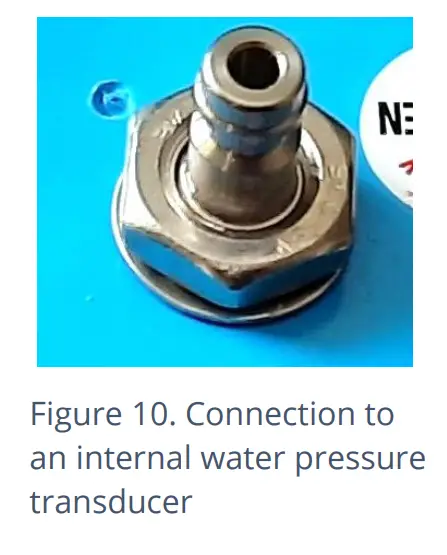
The Multilog2 supports a variety of sensors and parameter measurements. Exampo lo'o tu'uina atu i lalo: (Fa'alagolago i le numera fa'ata'ita'i na fa'atonuina).
- Omiga. Examples: – Direct connection to an internal transducer (referred to as an ‘internal’ pressure sensor). -Electrical connector for a wired transducer(referred to as an ‘external’ pressure sensor).
- Mamao to a water surface Example: – By using a SonicSens2 sensor. -By using a SonicSens3 sensor.
- Vai depth.Examples: – By using a SonicSens2 or SonicSens3 sensor. -By use of a submerged pressure gauge.
- Vai leak detection (from pressurized water pipes).Examples: – By use of a HWM Leak-Noise Sensor or Hydrophone.•Water (or Gas) Consumption (Flow rate / total consumption).ExampLes: – E avanoa ala 'Flow' 'ese'ese e fa'afetaui i mita eseese fa'aputugā fa'aputu.
- Temperature.ExampLe: – By use of a PT100 temperature sensor.
- Tulaga InputExample: – E iloa ai se ki matala/tapuni.
- Tulaga Output. Examples: – Pulse replication of Status Inputs. -To activate some external equipment.
- GPS input (communication from Global Positioning System satellites). Examples: – To determine current time (high accuracy).-To determine current location / confirm still at installation site.
- 0-1V input.(or 01-10V)(This is a generic sensor interface.The logger supports inputs from externally powered sensors).
- 4-20mA input. (This is a generic sensor interface.
- MODBUS
- SDI-12The logger supports inputs from externally powered sensors Optionally, the logger can provide power to compatible sensors). (This is a widely used interface for sensor communications. The logger supports inputs from externally powered sensors. Optionally, the logger can provide power to compatible sensors). (This is a widely used interface for sensor communications. The logger supports inputs from externally powered sensors).
- (O isi). Contact your sales rep for more information or to discuss your requirements.
For any given parameter, several sensors may be available with different types of electrical interface. Sensors provided by HWM will include a cable with a suitable connector for the supplied Multilog2.
FA'AVAE
AOTELEGA O LA'AGA FA'ATA'U
- Check that an assessment of the work has been done and that any safety measures are in place. (E.g., Safety precautions, protective clothing and/or equipment being used).
- Check the logger is suitable for use at the installation site.
- Check that you have the required sensors and antenna.
- Mafaufau po'o fea o le a tu'u ai meafaigaluega i totonu o le avanoa avanoa ma o uaea uma ma so'o se fa'agaau e talafeagai le umi.
- O lo'o avanoa mea fa'apipi'i e fa'afeso'ota'i i so'o se mea e fua ai le mamafa.
- O le logger, uaea, ma masini e tatau ona tuu ese mai punavai o le eletise e pei o afi poʻo pamu.
- O uaea ma fa'agaau e tatau ona ta'avale ma fa'amautu ina ia aua ne'i tupu ai ni lamatiaga. Aua ne'i fa'ataga so'o se masini e tu i luga o uaea, feso'ota'iga, po'o fa'agaau ona e ono afaina ai.
- Select the appropriate programming cable for the logger and attach it to the logger COMMS connector. Complete the connection path to the IDT host device (see sections 2.7 and 2.8). Use IDT to read the logger settings. (Refer to the IDT user-guide for guidance whenever needed).
- Fa'afou le firmware logger (pe a mana'omia).
(Refer to the IDT manual for guidance; consider downloading any existing data from the logger prior to upgrade). - Fa'aaoga le IDT e siaki pe suia ai fa'atulagaga logger o iai.
- Program a local time-zone into the logger (check or modify).
- Seti taimi vaeluaga mo le faia o fua (sample va ma le va log). E tatau ona fa'atulagaina e fa'atatau i mana'oga fa'apitoa a lau tusi talosaga (fa'aitiiti sampfua faatatau e fa'asao ai le ola maa).
- Check / modify channel settings to produce measurement samples and the required datapoints from each interface.
- Configure the logger channel to match the sensor or other equipment that the logger connects to.
(Check units of measure are correct, etc) - Ia mautinoa o loʻo faʻafanua le masini i le numera saʻo o le alalaupapa; O se fa'amatalaga lea e fa'aaoga pe a tu'uina atu fa'amaumauga o fua fa'amau i le server. (o lona uiga, e tatau ona fetaui numera o le alalaupapa i le va o le logger ma le DataG'ai).
(Note: For loggers using WITS protocol, requirements are different; refer to the guidance in the WITS supplement, MAN-147-0017). - Fa'aaogā so'o se galuega fa'afuainumera mana'omia ile fua fa'atua samples ina ia maua ai fa'amaumauga fa'amaumauga (taua fa'asaoina).
- Where required, undertake the setup of any additional options related to the channel. (E.g., add an initial meter reading, pulse replication setting, sensor calibration; these will be dependent on sensor and logger use).
- For pressure sensors, electrically attach them but expose the sensor to the local atmospheric pressure and re-zero them (using IDT) before commencing making a connection to the measurement point.
- Fa'apipi'i (tu'u ma fa'afeso'ota'i) fa'amau i lo latou tulaga fua.
- Fa'atoto so'o se so'oga i vai.
- Pe a mana'omia, fa'amama so'o se paipa e tumu i le vai e feso'ota'i i mea fa'aoso omiga e puipuia ai mai le aisa. (E mafai ona tu'uina atu ufi paipa fa'alumaina pe a talosagaina i se tau fa'aopoopo pe maua mai i le lotoifale mai se faleoloa meafaigaluega).
- Ensure any electrical connections made on site are dry, durable and water-tight.
- Fa'aaoga le IDT e:
- Test the logger and sensors are functioning correctly. (Some can be done pre-installation; others post installation).
- Seti le logger mo so'o se fa'ailo. Mafaufau i tulaga mo le faʻagaoioia o feʻau faʻailo ma tulaga mo le faʻailo e kilia.
- Check / modify the communications settings of device, as required:
- Fa'atonu SIM (parameters mo le tu'uina atu o le avanoa i feso'otaiga feavea'i).
- Modem settings (cellular network technology).
- Fa'atonuga o fa'amatalaga (fa'amatalaga feso'ota'iga a le server).
- Taimi e vala'au i totonu ma fa'atulagaga fa'akomepiuta.
- Verify any changes to settings have been saved prior to leaving site. Check that the logger is in a “recording” state.
- Afai e iai se feso'ota'iga antenna GPS a le logger, fa'apipi'i (tu'u ma fa'afeso'ota'i) le antenna GPS mo le pikiina o feso'ota'iga satelite.
- Use IDT to test the GPS installation is correctly working (GPS test).
- If used for obtaining a location fix, setup GPS location fix schedule and any GeoFence alarm requirements.
- Install (position and connect) the antenna for server communications.
- Use IDT to test the cellular communications performance.
- Ensure details of the site of logger deployment are recorded.
- (O le pulega mo le 'au'aunaga e mafai ona fa'atautaia e le aufaigaluega a le ofisa, po'o le fa'apipi'i e mafai ona fa'aoga le HWM Deployment app).
INSTALLING THE LOGGER
The logger must be mounted in a suitable location where the sensors to be attached can reach their intended installation points. Position loggers, sensors, and antenna away from sources of electrical interference such and motors or pumps. Cables and hoses should be routed without causing any hazards. Do not allow any equipment to rest on hoses, cables or connectors as crush damage can result.
The logger should be installed in the orientation shown in Figure 1 for optimum battery performance.
FA'ATAU IPU
The Multilog2 can be secured to a wall using a suitable bracket, an example of which is shown in Figure 11. Ensure the wall and fixings used are able to bear the weight of the logger and cables attached.
The bracket used may offer a potential mounting location for the antenna, although the installer should seek to find the optimal location for the antenna within the installation.
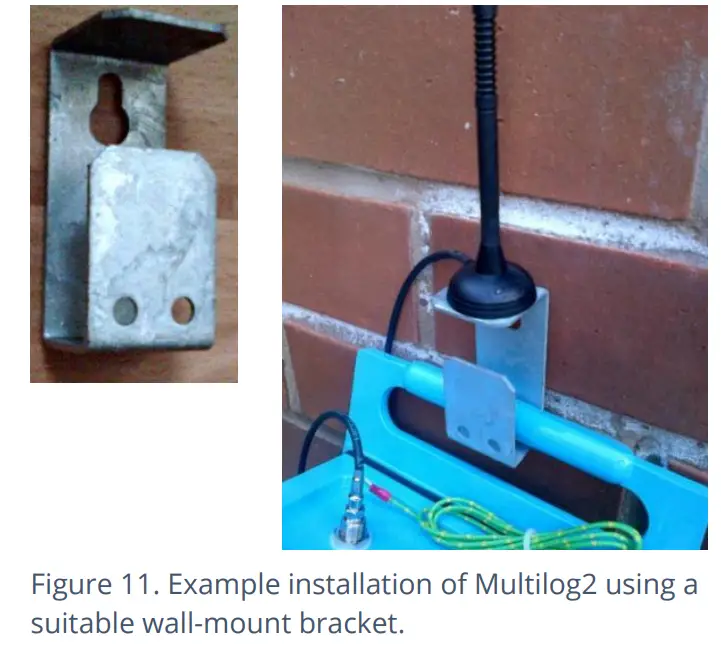
ELECTRICAL CONNECTIONS TO THE LOGGER
When making electrical connections to the logger (e.g., attaching a connector for a sensor), ensure the connector is correctly fitted. Both parts of the connector should be dry and free of debris. The connectors are keyed to ensure correct alignment of pins and receptacles. Align the sensor to the logger connector and push fully home. Then rotate the outer part of the sensor connector until it engages with the fastening mechanism and locks into place. The connector will then be secure and watertight.
When removing connections, follow the reverse steps of the procedure describe above. Always handle the connection by the connector; do not pull the cable as this could cause damage.
Route all cable so they do not cause any potential hazards and secure into place using suitable ties.
For antenna, follow the steps given in section 5.18.
FA'AIGA FA'ALEAGA
Fa'aaliga: O le logger e masani lava ona iai faʻatulagaga na muaʻi faʻapipiʻiina e le fale gaosimea aʻo leʻi lafoina. Ae ui i lea, o le faʻapipiʻi e iai le matafaioi mo le faʻamaonia o faʻatulagaga e talafeagai mo le faʻaogaina i le nofoaga faʻapipiʻi.
Afai e iai ni au mana'oga fa'apitoa e mafai ona fa'atalanoaina ma lou sui fa'atau HWM ile taimi ole fa'atonuina o le au fa'amau.
Where required, IDT can be used to check or make any changes to the logger settings.
Mo le tele o feso'ota'iga fa'alogo, mulimuli i ta'iala lautele i totonu ole ta'iala fa'aoga IDT; e tausisia e le logger le faʻamatalaga ma le examples of setup provided therein. However, some HWM sensors require specialized setup screens or have their own user-guide which provides further guidance.
FA'AIGA FA'AMATALAGA SENSOR
TOE FA'AVAE ZERO FACILITE (MO LE OMI FA'AFEAGAI I LE ATAMOSIFERA I LE LOOGA)
Pressure sensors supplied by HWM normally measure pressure relative to atmospheric pressure. Since there can be some variation in local atmospheric pressure (e.g., due to altitude), the loggers have a facility to re-zero the pressure sensor.
E tatau ona faia lenei mea i le masini e faʻaalia i le ea o le ea.
Prior to connecting the transducer to the actual measuring point, leave it exposed to air. Then “re-zero” the sensor using the method found in the IDT user-guide.
SENSOR OMI (TOTONOTO)
E mafai ona tu'uina atu se fa'aoga o le mamafa e pei o se mea fa'apipi'i (e pei ona fa'aalia i le Ata 10, i le itulau 14), lea e fa'afeso'ota'i sa'o i le vai e ala i se fa'agaau e fa'aaoga ai se feso'ota'iga fa'asao vave.
Fa'aaliga: Do not connect the sensor to the measurement point before going through the re-zero (to local atmospheric pressure) process, if required.
Fa'afeso'ota'i le ta'i fa'amau i le paipa (mea e fua ai) i le fa'aliliuina o le mamafa o le logger e fa'aaoga ai se fa'agaau feso'ota'i talafeagai. (Mo se example, tagai i le Ata 12.) Ia mautinoa ua tafe toto le faagaau, mo le faagaoioiga sa'o.
O lenei fa'aoga ua fa'avasegaina ile fale gaosimea. Leai se fa'avasegaina i luga ole nofoaga e mana'omia.
Fa'aaliga: Add insulation to the pipe and logger to prevent freezing.
If the water in the hose or the logger itself freezes, there is a danger of permanent damage to the pressure transducer.
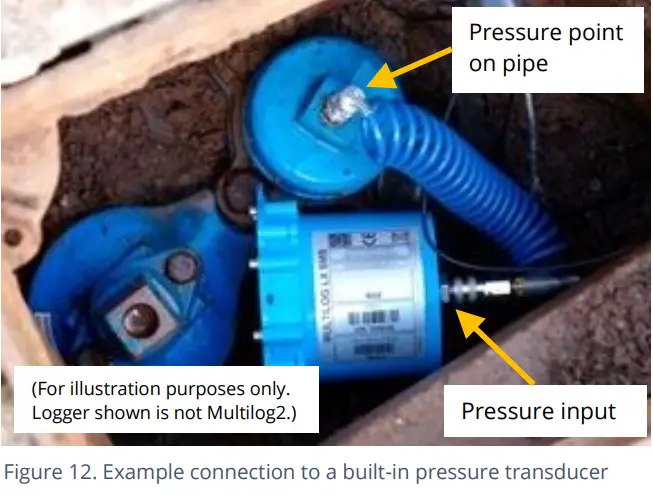
SENSOR OMI (FAFO)
A pressure input may be presented as an electrical interface, using a 4-pin or 6-pin MIL-Spec connector (see Figure 9 on page 14).
Cabled pressure sensors for the Multilog2 are available from HWM. For most situations, sealed type pressure (or depth) sensors are used, and the sensor will be wired directly to the connector, as shown in Figure 13.
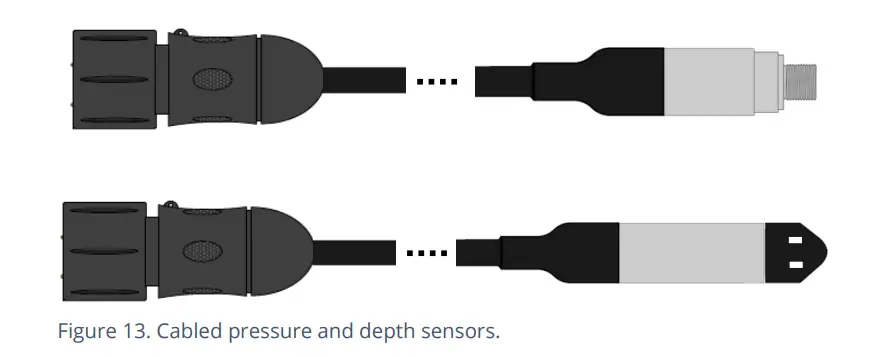
E fa'aaoga e le logger mo sina taimi le mana i le masini a'o le'i (ma le taimi) faia se fua.
The logger interface will be labelled “Pressure (20 bar)” (or similar).
The pinout of the connectors are shown below.
| Logger bulkhead connector pinout : 4-pin External Pressure | |||
| A | B | C | D |
| V (+); (PWR) | V (+); (Fa'ailoga) | V (-) ; (PWR) | V (-) ; (Fa'ailoga) |
| Logger bulkhead connector pinout : 6-pin External Pressure | |||||
| A | B | C | D | E | F |
| V (+); (PWR) | V (+); (Fa'ailoga) | V (-) ; (PWR) | V (-) ; (Fa'ailoga) | GND / Screen | (le feso'ota'i) |
Where a pressure transducer has a threaded end for connection to the pressure measurement point, fittings may be required to modify the connection (e.g., a quick-release connector for connection to a hose). For example, tagai i le Ata 14.
Assemble any fittings prior to connecting to the logger.
Straight or elbow styles of coupling kits are available.
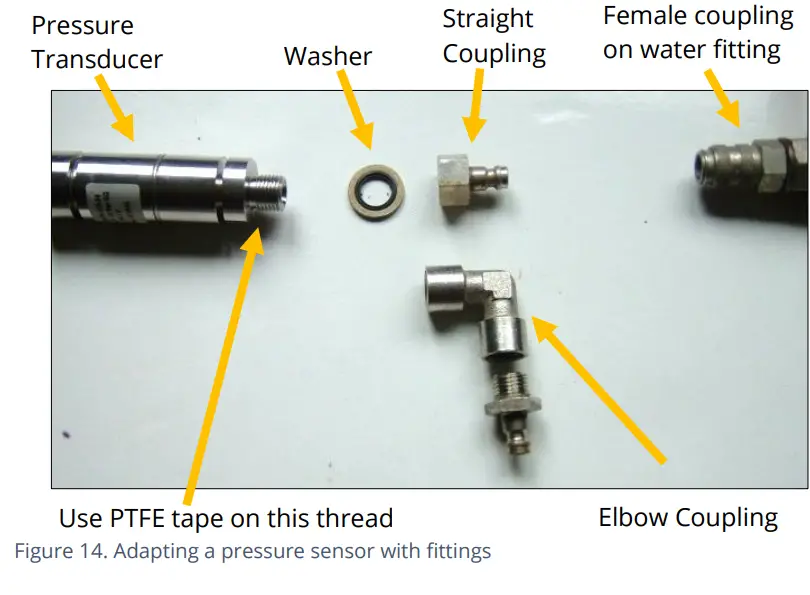
Fa'amaonia o lo'o i ai i le logger le fa'aoga talafeagai mo le mamafa po'o le loloto o le masini. Ona faʻafesoʻotaʻi lea o le masini i le faʻaoga logger talafeagai.
Fa'aaliga: Aua ne'i fa'afeso'ota'i le masini i le mea e fua ai a'o le'i faia le fa'asologa o le fa'avasegaina (silasila i lalo) ona toe-zero (i le mamafa o le ea i le lotoifale).
Mo se masini fa'apipi'i, fa'apipi'i i le mea e fua ai ma (pe a talafeagai) fa'amatoto so'o se fa'agaau fa'afeso'ota'i.
Mo se masini loloto, e tatau ona mamafa i lalo pe fa'apipi'i lelei le masini i le pito i lalo ole alavai, fa'aaoga se mea fa'apipi'i (fa'ata'ita'iga, se ipu fa'amomoli po'o se fa'amau fa'amau) pe a mana'omia. E tatau fo'i ona fa'amautu le uaea ina ia taofia ai le gaioi o le vai mai le galue i luga o le uaea e toso ese ai le masini mai le tulaga pe fa'amalosia so'o se feso'ota'iga.
Fa'asologa Fa'asologa (fa'aoga tau fa'avasega mai le uaea):
A'o le'i fa'aogaina le masini, e tatau ona fa'avasega le logger ma le pa'aga e tu'u sa'o ai faitauga.
O lenei metotia e mafai ona faʻaogaina e se faʻapipiʻi e faʻapipiʻi ma faʻavasega se masini faʻamalosi i le logger.
E masani ona i ai fua fa'avasegaina o lo'o fa'aalia ile uaea (va'ai le Ata 15). Fa'aaoga le IDT e fa'aopoopo ai fa'amatalaga mai le fa'ailoga fa'avasegaina i luga o le uaea i totonu o le logger e fa'aaoga ai le ta'iala i totonu ole ta'iala fa'aoga IDT.
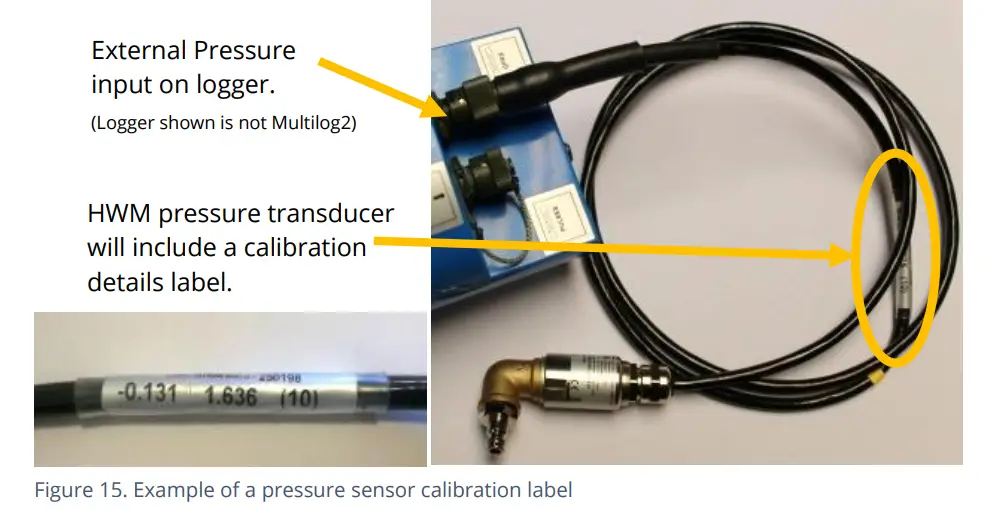
O le fa'asologa o le fa'avasegaina e tatau ona tupu a'o le'i toe fa'a-zero le masini fa'amalosi.
A maeʻa ona mulimulitaʻia le faʻasologa o le faʻavasegaina ma le toe-zero, e mafai ona maua le transducer i (pe faʻapipiʻi i) lona tulaga fua.
The logger must be correctly set up to make measurements from the sensor. Refer to the IDT user-guide for further details.
Fa'asologa o le Fa'avasegaina (fa'aogaina o le mamafa fa'atatau):
This method can be used by an authorized service center to pair and calibrate a pressure sensor to the logger.
O le metotia e aofia ai le faʻaogaina o faʻamatalaga faʻamalosi i le transducer ma fausia se laulau o faʻatusatusaga tau.
FA'A'OGA FA'AVAE FA'ALU (METER PULSE COLLECTION)
Depending on the model supplied, the logger may have 0, to 6 Flow inputs. These are digital inputs, designed to sense the open or closed condition of a switch (activated by the installed meter). To use the flow channel(s) the logger must be set up (using IDT) to know what each meter pulse represents.
FA'AMATALAGA O AUALA LAVA MA FA'AALIGA FA'AALIGA
Flow of a fluid in a pipe is usually detected by a meter, which produces pulses related to the volume of fluid passing through it. There are several types of meters; some can detect both forward flow and reverse flow (bi-directional flow); some can detect flow in one direction only (uni-directional flow). There are therefore several ways of implementing the meter pulse output signals from a meter. Your logger must have the correct interface and settings for the signaling from the meter to be compatible with it.
The Multilog2 Flow inputs sometimes require two input signals in order to work with the meter-pulse signaling of certain meters. A pair of inputs can therefore sometimes be configured to operate as a single channel. Other meter types only require one signal, so the pair of inputs can operate as two separate channels.
The pair of Flow signals can be labeled in one of the following ways:
| Alternative signal names | ||||
| Pair of FLOW
faailoilo |
Flow Input 1 | tafe 1 | Pusa | Flow (Forward) |
| Flow Input 2 | tafe 2 | Fa'atonuga | Flow (Reverse) | |
| masani | GND | |||
The labeling depends on the factory default for the configuration of the Flow channels on your logger model-number, but sometimes alternative types of configuration can be achieved by changing logger settings.
Afai o le logger ua muai faʻapipiʻiina e le fale gaosi oloa e naʻo le 1 Flow channel (datapoint stream), e mafai ona faʻaogaina le paʻu o mea i totonu o se tasi o auala eseese e tolu:
(1) Input 1 can be used with a Uni-directional meter (one which only measures forward flow / consumption).
For use in this configuration:
• Input 1 acts to collect meter pulses, and
input 2 is usually left disconnected (or allocated to use as a ‘Tamper Alarm’, or used as a Status input).
(2) Inputs 1 and 2 can be used as a pair with a Bi-directional meter (one which can measure both forward and also reverse flow).
For use in this configuration:
• Input 1 acts to collect meter pulses, and
• input 2 is used for the flow direction indication from the meter
(open = forward flow, closed = reverse flow).
(3) Inputs 1 and 2 can be used as a pair with a Bi-directional meter (one which can measure both forward and also reverse flow).
For use in this configuration:
• Input 1 acts to collect meter pulses (forward flow direction), and
• input 2 acts to collect meter pulses (reverse flow direction).
Where the logger is pre-configured by the factory to produce 2 Flow channels
(datapoint streams), the pair of inputs can be used as 2 independent uni-directional Flow input channels (channels 1 and 2).
Each input can be used with a Uni-directional meter (one which only measures forward flow / consumption).
E ala ile LOGGER 4-PIN BULKHEAD CONNECTOR
Multilog2 Flow signal inputs are presented on a 4-pin connector (see Figure 9 on page 14). Each connector has a pair of Flow signal inputs.
O le pine o lenei so'oga o lo'o fa'aalia i lalo:
| Logger bulkhead connector pinout : 4-pin Flow Inputs | ||||
| Pin | A | B | C | D |
| Fa'ailoga | (le feso'ota'i) | Flow Input 1 | Flow_GND | Flow Input 2 |
Check the meter to which the logger is going to be connected and ensure its meter pulse signaling method is understood, along with the significance of each meter pulse.
Connect the logger to the meter-pulse outputs of the meter using a suitable cable. If cables with bare tails have to be interconnected, refer to the guidance in section 5.5.
Use IDT to complete the setup, ensuring the logger is correctly set to interpret the meter pulses. If the logger is required to keep track of the meter counter display, take an initial reading of the meter counter and program it into the logger. The logger uploads additional consumption regularly, so a meter reading can be made remotely.
SO'O'I UIGA LE'I MATUA I METOGA
When using a cable that is unterminated, an installer will be required to make their own connection to the other equipment on site.
When making a connection to Multilog2 you will normally need to splice the bare tails together. It is important that a waterproof connector housing is used, such as the “Tuff-Splice” enclosure available from HWM.
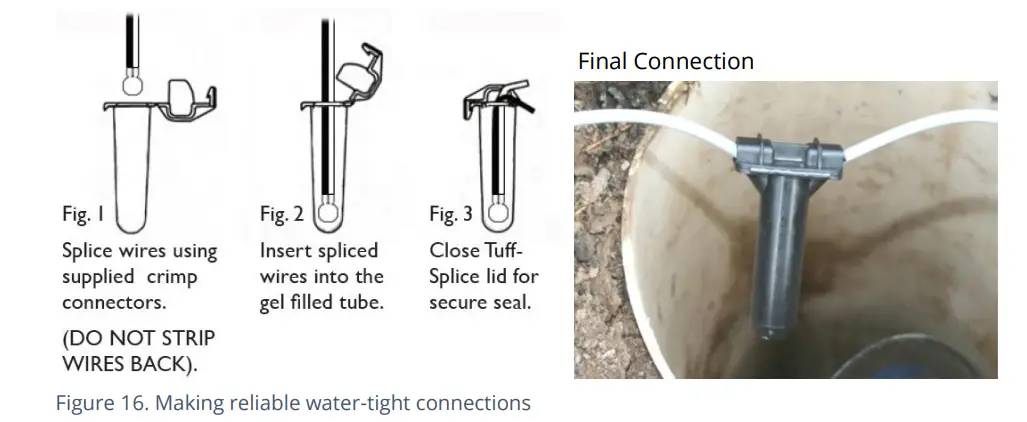
Fa'aaliga: Long data connections should always be made using screened cable. The use of screened cable will ensure maximum rejection of interference from outside sources. Always use a common ground point without creating ground loops.
TULAGA INPUT
The Status Input pins are a re-purposed use of the Flow input electronics (see section 5.4). A change in the software driver for the connector gives the input pins a different functionality.
The interface will be labelled as ‘Status’ or ‘Dual Status’.
O le pine o lenei so'oga o lo'o fa'aalia i lalo:
| Logger bulkhead connector pinout : 4-pin Status Inputs | ||||
| Pin | A | B | C | D |
| Fa'ailoga | (le feso'ota'i) | Status Input 1 | Status_GND | Status Input 2 |
The Status Input signals can be configured for general-purpose use in detecting switch contacts. This has many uses.
eg
- Detection of door / window / equipment-access openings for security purposes.
- A ‘spare’ pin on a flow channel can be used to generate a ‘tamper’ alarm in the event that the logger cable is cut or removed from the meter.
(The meter must support this facility by providing a closed loop from the tamper input to the return pin, Status_GND).
Connect the logger to the external equipment using a suitable cable. If cables with bare tails have to be interconnected, refer to the guidance in section 5.5.
Use IDT to complete the setup, ensuring the logger is set to generate the desired alarm.
OUTPUTS (DIGITAL SWITCH: OPEN/CLOSED)
Multilog2 Outputs are presented on a 3-pin connector (similar to Figure 8 on page 14). Up to four outputs can be supported. Each connector has a pair of outputs.
The interface will be labeled as ‘Dual Output’.
O le pine o lenei so'oga o lo'o fa'aalia i lalo:
| Logger bulkhead connector pinout : 3-pin Outputs | |||
| Pin | A | B | C |
| Fa'ailoga | Galuega Faatino 1 | Galuega Faatino 2 | GND |
The logger does not supply any power to the output. The output takes the form of an electronic switch (transistor), which can either be open or closed. When closed, the current path or is between the output pin and ground.
Ole fua maualuga ole voltage is 12V (D.C.)
The maximum rated current is 120mA.
A common use of the Output pins is for pulse replication (of meter pulses that are input to the Flow channels). Where this is implemented:
- Flow input 1 is replicated to Output 1
- Flow input 2 is replicated to Output 2
- Flow input 3 is replicated to Output 3
- Flow input 4 is replicated to Output 4
The Output signals may also be used to activate external equipment.
In order to use the outputs, a suitable cable is required (the exact requirements will depend on the equipment the logger is being used with; discuss with your HWM representative). If cables with bare tails need to be interconnected, refer to the guidance in section 5.5.
Use IDT to complete the setup, depending on your application for the output.
MA'A I FAFO
The use of an external battery is optional for many installations but may be required to support the logger in order to obtain the required length of service.
For best battery life, orient the external battery in its preferred orientation (refer to the labelling on the battery). Batteries are heavy devices. When positioning the battery, check that it is not crushing any cables or tubes within the installation. Ensure the battery is secure in its installation position (so it cannot fall). Then connect it to the logger.
The logger connection for an external battery will be presented via a (6-pin or 10 pin) connector that is shared with the programming interface (labelled “COMMS”).
The cable that is used for interconnecting the external battery pack to the logger will only include the pins required for supply of power; pins assigned for communications purposes will not be fitted.
The external battery connection must be temporarily disconnected whenever a logger programming cable needs to be attached.
SONICSENS 3 (ULTRASOUND DISTANCE / DEPTH SENSOR)
Where a SonicSens3 interface is available on your logger, it will have a 6-pin connector, similar to that shown in Figure 8, on page 14.
The interface provides power and communications to the sensor, which measures distance to a fluid surface. By input of other parameters (e.g., distance from the bottom of the water channel) the logger can calculate water depth. It can also derive a variety of other measurements such as flow rates if situated near an open weir.
Va'ai ile SonicSens-3 user-guide (MAN-153-0001) mo fa'atonuga ile fa'apipi'i ma le setiina o le sensor mo le fa'agaioia.
Fa'aaliga: Multilog2 loggers are not of an intrinsically safe construction, and so cannot be used within an environment where a potentially explosive atmosphere may be present.
SONICSENS 2 (ULTRASOUND DISTANCE / DEPTH SENSOR)
Where a SonicSens2 interface is available on your logger, it will have a 4-pin connector, as shown in Figure 8, on page 14.
The interface provides communications to the sensor, which measures distance to a fluid surface. By input of other parameters (e.g., distance from the bottom of the water channel) the logger can calculate water depth. It can also derive a variety of other measurements such as flow rates if situated near an open weir.
Va'ai ile SonicSens-2 user-guide (MAN-115-0004) mo fa'atonuga ile fa'apipi'i ma le setiina o le sensor mo le fa'agaioia.
Fa'aaliga: Multilog2 loggers are not of an intrinsically safe construction, and so cannot be used within an environment where a potentially explosive atmosphere may be present.
TUSI FA'AVAE (RTD – PT100)
The logger may be constructed with a 4-pin connector (see Figure 9, on page14) for connection of a temperature sensor. Typically, this will be a PT100 RTD sensor. The logger interface will be labeled “TEMP” or similar).
The pinout of the connectors is shown below.
| Logger bulkhead connector pinout : 4-pin Temperature (RTD -PT100) | |||
| A | B | C | D |
| Temp_V + | Temp_S + | Temp_V – | Temp_S – |
| Logger bulkhead connector pinout : 6-pin Temperature (RTD -PT100) | |||||
| A | B | C | D | E | F |
| Temp_V + | Temp_S + | Temp_V – | Temp_S – | GND / Screen | (le feso'ota'i) |
Ina ia faʻaaogaina le masini vevela, e manaʻomia le faʻavasegaina o mea e tuʻuina atu.
When ordered with a temperature sensor from HWM, the sensor will have the correct connector fitted for the Multilog2 logger. The logger input will also be factory calibrated for use with the supplied sensor.
LNS INPUT (LEAK-NOISE SENSOR / HYDROPHONE)
The logger may be constructed with a 4-pin connector (see Figure 9, on page14) for connection of a high sensitivity audio sensor, used for detecting the noise of a leak from a pressurized water pipe.
The interface will be labeled ‘LNS INPUT’ (or similar).
Typically, the sensor will be a Leak Noise Sensor from one of the HWM PR4LNS-1 family. The Multilog2 is also compatible with the Hydrophone-2 sensor (and its earlier version, Hydrophone). Both use the same connector. There are only minor differences in setup of the logger for their use. There are significant differences in their installation methods.
Fa'apipi'iina o le fa'amaneta ituaiga LNS sensor:
E fa'aogaina e le logger le masini e fa'alogo ai i leo na gaosia mai le paipa. Ona fa'aogaina lea o algorithms fa'apitoa e fa'amasino ai pe o iai se liki i tafatafa ane.
O le fa'alogo leo i totonu o le iunite LNS o lo'o fa'apipi'i i fafo o le feso'ota'iga paipa mo le fa'aoga, e masani ona fa'aoga se maneta e fa'apipi'i ai i se aseta paipa u'amea (vai po'o le valve) i totonu o se potu. Va'ai ile Ata 17.
E tatau ona fa'apipi'i lelei le masini i le pito i luga o le aseta, ma fa'asaga i lalo le masini. (E faʻaitiitia ai le lamatiaga o le paʻu o le sensor).
Aʻo leʻi faʻapipiʻi le masini, faʻamama le mea e faʻapipiʻi ai aseta ma aveese soʻo se ele mai ai, faʻaaoga se pulumu uaea; e mautinoa ai o le a lelei le fa'afeso'ota'i ma le paipa (mo le fa'auluina o le leo).
Ona faʻafesoʻotaʻi lea o le uaea sensor i le logger.
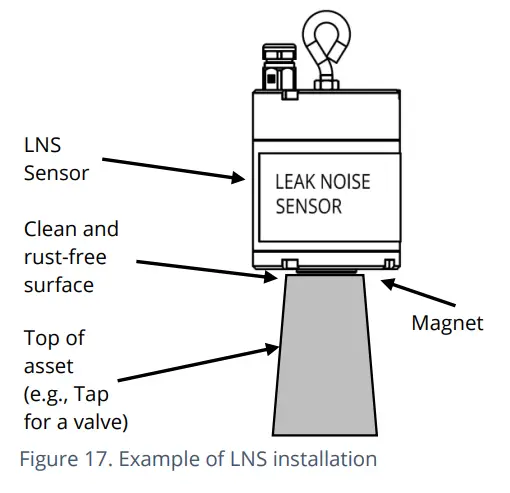
Fa'atuina o le masini Hydrophone-2:
O le fa'alogo leo i totonu o le Hydrophone-2 e fa'afeso'ota'i sa'o i le vai i totonu o le paipa e ala i se mea e fa'aoga ai, e pei o le vai (silasila i le Ata 18). Ole mea lea e maua ai le umi ole fa'agaioiga nai lo le LNS, aemaise ile paipa palasitika.
Installing the unit into the water network can be a dangerous operation unless carried out correctly. Refer to the Hydrophone-2 user-guide
(MAN-165-0001) for installation and use details.
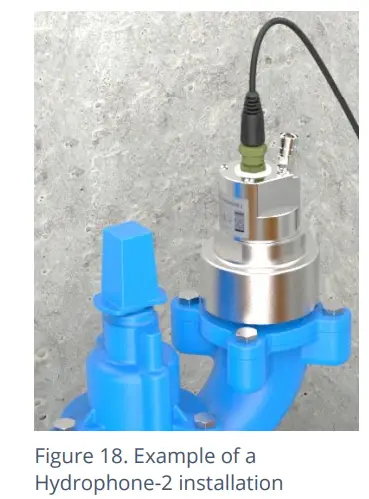
Amioga a Logger ma Server:
The use of a Leak-Noise sensor or Hydrophone can cause some changes (additions) to the logger’s pattern of behavior. This section provides a summary of the loggers use of the sensors; For a detailed explanation, refer to the PermaNet+ with Hydrophone-2 user-guide (MAN-148-0007).
O le gaioiga mai le logger o le a aofia ai le tele o taʻiala, o ia mea taʻitasi o le a avea ma faʻamatalaga faʻamatalaga.
O tapula'a e iloa ai le leak o le a aofia ai:
- Tulaga
- Fa'asalalau
- Leak / No-leak judgment
Mo le tele o fa'apipi'iina o feso'ota'iga vai, e masani lava ona fa'atino e le logger se fa'ata'amilosaga su'ega liki tele fa'atasi i le aso. Ae peita'i, a fa'aoga e mata'ituina vaega taua ole feso'ota'iga vai, e pei ole ogalaau autu, e maua se isi ta'amilosaga su'ega (e ta'ua o le 'Trunk Main' mode); Ole mea lea e fa'atino ai se su'ega su'esu'ega leo pu'upu'u e sili atu i taimi uma, ina ia mafai ai ona tu'uina atu se fa'amatalaga muamua o fa'afitauli fa'aletonu.
I le fa'aopoopoina i fa'amaufa'ailoga e iloa ai le liki, e mafai e le logger ona maua isi ituaiga fa'amatalaga fa'aopoopo, e pei o pu'e leo (leo leo. files). O lo'o tu'uina atu fo'i i le 'au'aunaga ma e mafai ona fa'alogo mamao e se tagata fa'aoga poto masani, e fai ai se fa'amasinoga pe tutusa le leo ma le leo o le vai.
If the logger can find a highly accurate time reference from where it is installed
(e.g., from the cellular communications network or a GPS satellite), a high-accuracy time-stamp o le a feso'ota'i i le leo file.
E mafai e le 'au'aunaga ona tu'uina atu le nofoaga e fa'aputuina ai le tele o loggers (fa'alenu'u o le tasi i le isi) o lo'o lipotia mai se liki ona siaki lea mo pu'ega leo. O le tuʻuina atu o faʻamaumauga leo na faia i le taimi lava e tasi, e mafai e le 'auʻaunaga ona faʻaogaina e taumafai e suʻe le tulaga o le ono mafai ona tafe i luga o le paipa.
O isi fa'amatalaga e mafai ona maua mai i le logger o le histograms o le pisa (e iloilo ai pe na tupu se suiga i uiga pi'o paipa talu ai nei).
ANALOGUE VOLTAGE FA'AVAE (0-1V, 0-10V)
E mafai ona fausia le logger i se feso'ota'iga 4-pin (silasila i le Ata 8, i le itulau 14) mo le feso'ota'iga o se masini e fa'aogaina ai se voluma.tage level as a method of signalling. Both a 0-1V and a 0-10V input interfaces are available on Multilog2 but must be specified at the time of ordering.
Le logger e le tuʻuina atu le mana i le masini; e tatau ona i ai lona lava puna o le mana.
O le pine o lenei so'oga o lo'o fa'aalia i lalo:
| Logger bulkhead connector pinout : Voltage Input 0-1V (& 0-10V) | ||||
| Pin | A | B | C | D |
| Fa'ailoga | (le feso'ota'i) | 0-10V + /
0-1V + |
(le feso'ota'i) | 0-10V – /
0-1V – |
O le tele o ituaiga masini e maua i lenei fa'aoga.
When ordered from HWM, the sensor will have the correct connector fitted for the Multilog2 logger.
E tatau i le tagata fa'apipi'i ona fa'aoga le IDT e fa'amautu ai pe fetu'una'i tulaga o le logger e fa'a sa'o le fua ma fa'auiga fa'atatau o le tino o lo'o fa'aogaina le masini fa'apipi'i e iloa ai.
ANALOGUE CURRENT INPUT (4-20MA)
The logger may be constructed with a 4-pin connector (see Figure 8, on page 14) for connection of a sensor which employs an output current as a method of signalling.
Two interface types are available:
- Pa'u.
- Malosi.
4-20MA (PASSIVE)
Where a ‘passive’ 4-20mA interface is fitted, the logger does not provide power to the sensor; it must have its own source of power.
The logger interface will be labelled “4-20mA” (or similar).
O le pine o lenei so'oga o lo'o fa'aalia i lalo:
| Logger bulkhead connector pinout : Current Input (4-20mA) | |||
| A | B | C | D |
| (le feso'ota'i) | 4-20mA + | (le feso'ota'i) | 4-20mA – |
O le tele o ituaiga masini e maua i lenei fa'aoga.
When ordered from HWM, the sensor will have the correct connector fitted for the Multilog2 logger.
E tatau i le tagata fa'apipi'i ona fa'aoga le IDT e fa'amautu ai pe fetu'una'i tulaga o le logger e fa'a sa'o le fua ma fa'amatala fa'amaufa'ailoga fa'aletino o lo'o fa'aogaina e le masini e iloa ai.
4-20MA (ACTIVE)
Where an ‘active’ 4-20mA interface is fitted, the logger can provide power to a compatible sensor.
The logger interface will be labelled “4-20mA (Active)” (or similar).
O le pine o lenei so'oga o lo'o fa'aalia i lalo:
| Logger bulkhead connector pinout : Current Input (4-20mA) | |||
| A | B | C | D |
| V+ (PWR) | 4-20mA + | GND (PWR) | 4-20mA – |
A wide variety of sensors are available with this interface. However, not all have the same power requirements. The connector is able supply up to 50mA of current. The output voltage is variable (from 6.8 V to 24.2 V, in 32 steps), and is able to be set using IDT.
To avoid damage: Prior to connecting the sensor, use IDT to ensure the correct output voltage for the sensor is set.
The logger does not supply continuous power to the interface, but only activates it for a short time whilst making a measurement. IDT gives access to controls to set the amount of time the sensor has power applied prior to and during measurement. The installer can set these to allow for any initialisation or settling time the sensor requires.
When ordered from HWM, the sensor will have the correct connector fitted for the Multilog2 logger.
E tatau i le tagata fa'apipi'i ona fa'aoga le IDT e fa'amautu ai pe fetu'una'i tulaga o le logger e fa'a sa'o le fua ma fa'amatala fa'amaufa'ailoga fa'aletino o lo'o fa'aogaina e le masini e iloa ai.
The interface can also be used with sensors having their own source of power.
FA'AIGA FA'AVAE (SDI-12)
E mafai ona fausia le logger i se feso'ota'iga 4-pin (silasila i le Ata 8, itulau 14) mo feso'ota'iga i masini e fa'aogaina ai le SDI-12 auala e fa'ailo ai; o se fa'amatalaga fa'asologa fa'asologa lea. O meafaigaluega i fafo e faʻauluina soʻo se masini eletise; e mafai ona fa'apipi'i i ai se tasi po'o le tele o masini.
The logger does not provide power to the SDI-12 interface. The attached equipment / sensor must have its own source of power.
The logger interface will be labelled “SDI-12” (or similar).
The pinout of the connector is shown below:
| Logger bulkhead connector pinout : SDI-12 | |||
| A | B | C | D |
| SDI-12_Data | (RS485,
Unused) |
Comms_GND | (RS485,
Unused) |
O le tele o ituaiga masini e maua i lenei fa'aoga.
When ordered from HWM, the sensor will have the correct connector fitted for the Multilog2 logger.
Fa'aaliga: Ensure the attached sensor has the SDI-12 protocol selected, otherwise communications will fail.
I le faʻaaogaina o le SDI-12 protocol, e mafai e le logger ona fai se talosaga mo se fuataga i meafaigaluega faʻapipiʻi. E tali mai meafaigaluega fa'apipi'i pe a maua le fua.
O meafaigaluega fa'alogo o le ai ai se tuatusi e tatau ona fa'aoga e le logger pe a feso'ota'i i ai. O le mauaina o faʻamatalaga e amata ile logger e talosagaina se fua (auina atu se "M" poloaiga poʻo se "C" poloaiga).
O nisi masini fa'alogo o le a auina atu ni mea se tele o fa'amaumauga o fua o se poloka
(fa'ata'ita'iga, tasi le vaega o meafaigaluega e mafai ona aofia ai le tele o masini). O le seti o le logger e mafai ona aofia ai se faasino igoa e filifili ai faʻamatalaga manaʻomia mai le poloka.
E tatau i le tagata fa'apipi'i ona fa'aoga le IDT e fa'amaonia pe fetu'una'i tulaga o le logger e talosagaina ai fa'amaumauga mana'omia mai le masini. O le setiina o le logger e tatau ona aofia ai tuatusi talafeagai, poloaiga, ma fa'asino igoa e mana'omia e amata ai le fua ona filifili lea o mea fa'amaumauga patino e mana'omia.
E mana'omia le fa'apipi'i e fua sa'o ma fa'amatala fa'amaufa'ailoga fa'aletino o lo'o fa'aogaina e le masini e iloa ai.
FA'AALIGA FA'AVAE (RS485 / MODBUS)
The logger may be constructed with a 4-pin connector (see Figure 8, on page 14) for connection of a sensor which employs the RS-485/MODBUS method of signalling; this is a serial data interface.
Fa'aaliga: Ensure the attached sensor has the RS485/MODBUS protocol selected, otherwise
communications will fail.
E lua ituaiga o faʻaoga MODBUS o loʻo avanoa:
- Pa'u.
- Malosi.
Mo se atinaʻe Passive, e le tuʻuina atu e le logger le mana i le masini; e tatau ona i ai lona lava puna o le mana.
For an Active interface, the logger provides temporary power to the sensor, just before (and during) the measurement cycle.
The port type (active or passive) can be determined by inspection as to whether (or not) there is a voltage output control shown within IDT. In addition, the connector label will indicate ‘MODBUS’ or ‘POWERED MODBUS’.
A wide variety of sensors are available with this interface. When ordered from HWM, the sensor will have the correct connector fitted for the Multilog2 logger. In addition, the sensor type will have been tested with the logger to confirm compatibilty for use to obtain certain measurements. However, this may require selecting a specific driver for the sensor within IDT.
The Multilog2 operates as the master device when using the Modbus protocol. It sends setup instructions and other information to the attached sensor equipment (which operates in slave mode). The protocol includes the ability to address each register in order to read and (depending on the attached unit) write to the registers. Measurement results are made available to the logger by reading them from specific registers in the sensor equipment over the Modbus link.
O meafaigaluega fa'alogo o le ai ai se tuatusi e tatau ona fa'aoga e le logger e iloa ai pe a feso'ota'i. O le setiina o le logger e tatau ona aofia ai le tuatusi o le masini faʻapea foʻi ma faʻamatalaga avanoa mo le resitala (code code, tuatusi resitala amata).
The quantity of registers to be read will depend on the format of the data within the sensor registers. The logger can handle multiple formats of numeric data (e.g., 16-bit signed, 16-bit unsigned, float, double); however, the expected data format must be specified in the logger setup; this will ensure that the required number of registers are read and that the data is correctly interpreted by the logger. The read data can then be used to obtain the channel datapoints.
When setting the logger for use with your sensor, usually the “generic” settings are suitable. However, some modification of the logger operation is required for certain types of sensor equipment in order to get the best out of them. IDT provides a control to select specific sensors from a list. Once chosen, the logger will handle any peculiarities of the behavior of the sensor, its protocol, or additional needs for the measurement being taken (e.g., additional exchanges of information between the logger and the sensor equipment).
Refer to the IDT user-guide regarding how to set up the RS485 / Modbus interface. This must be read in conjunction with the user-guide of the equipment that is being attached; this will provide information on the measurements available from the sensor equipment registers (and the numeric format of the data), and how to initiate register reads to obtain the required data.
The installer should use IDT to confirm or adjust the settings of the logger that request the required measurement data from the sensor. Then use IDT to correctly scale and interpret the physical parameters the sensor is used to detect.
RS485 / MODBUS (PASSIVE)
The logger interface will be labeled “MODBUS” (or similar).
O le pine o lenei so'oga o lo'o fa'aalia i lalo:
| Logger bulkhead connector pinout : RS485 / MODBUS (passive) | |||
| A | B | C | D |
| (SDI-12,
Unused) |
RS485_A | Comms_GND | RS485_B |
O le tele o ituaiga masini e maua i lenei fa'aoga.
When ordered from HWM, the sensor will have the correct connector fitted for the Multilog2 logger. In addition, the sensor type will have been tested with the logger to confirm compatibilty for use to obtain certain measurements. However, this may require selecting a specific driver for the sensor wihin IDT.
The installer should use IDT to confirm or adjust the settings of the logger to request the required measurement data from the sensor. Then use IDT to correctly scale and interpret the physical parameters the sensor is used to detect.
RS485 / MODBUS (ACTIVE)
The logger interface will be labeled “POWERED MODBUS” (or similar).
Fa'aaliga: When supplied with (and configured for) a known sensor, the logger MODBUS interface may alternatively be labeled so as to identify the sensor itself. Examples o:
- Raven Eye
O le pine o lenei so'oga o lo'o fa'aalia i lalo:
| Logger bulkhead connector pinout : RS485 / MODBUS (active) | |||
| A | B | C | D |
| V+ (PWR) | RS485_A | GND | RS485_B |
For an ‘Active’ interface, the logger usually provides temporary power to the sensor, just before (and during) the measurement cycle. The sensor used must be compatible with the logger power supply to the interface (voltage and current output). It also has to be compatible with the timing of the power activation and any exchange of messages. Consult your HWM representative for advice on sensor compatibility or if you have any specific sensor requirements.
A wide variety of sensors are available with this interface. However, not all have the same power requirements.
To avoid damage, check the sensor is compatible with the logger power supply range and use IDT to check that the logger power settings have already been correctly set prior to connection.
- The interface is able supply up to 50mA of current.
- Le galuega faatino voltage can be set using IDT (from 6.8 V to 24.2 V, in 32 steps).
IDT gives access to controls to set the amount of time the sensor has power applied prior to and during measurement. The installer can set these to allow for any initialization or settling time the sensor requires.
When ordered from HWM, the sensor will have the correct connector fitted for the Multilog2 logger. In addition, the sensor type will have been tested with the logger to confirm compatibility for use to obtain certain measurements. However, this may require selecting a specific driver for the sensor within IDT.
The installer should use IDT to confirm or adjust the settings of the logger to request the required measurement data from the sensor. Then use IDT to correctly scale and interpret the physical parameters the sensor is used to detect.
ATENNA INPUT (GPS SATELITI)
The Multilog2 may have been fitted with an internal radio receiver which can receive signals from GPS satellite stations. These loggers will have an additional antenna connector fitted, which must be connected to a GPS antenna for correct operation.
Fa'aaliga: Do not confuse this with the antenna supplied for cellular communication, as they are not compatible with each other.
The GPS antenna can be identified by the “GPS” indication on its cable, as shown in Figure 19.
O se tasiampO lo'o fa'aalia le ituaiga 'puck' antenna GPS.
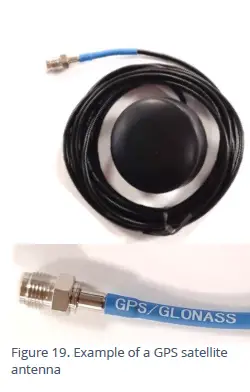
The connector will be labeled as ‘GPS TSYNC’ or ‘GPS CONNECTOR’ (or similar).
O le antenna e tatau ona faʻapipiʻi i luga aʻe o le eleele ma faʻatasi ai ma se laina saʻo o le vaʻai i le lagi (ia pikiina faʻailoga leitio mai satelite taamilo).
ExampO nofoaga nei:
- Fa'asaga i luga o se kapoti po'o se pou, fa'asino i luga.
- Fa'amau i totonu o le pito i luga o se tapuni potu e fa'aogaina lelei, toe fa'asino i luga.
Pe a faʻapipiʻi le antenna i se tapuni o potu, e manaʻomia le tapuni e vili i fafo e faʻaoga ai le tino o le antenna. O le malologa e tatau ona lava le loloto e puipuia ai le antenna mai le faaleagaina. O se example o laasaga manaʻomia o loʻo mulimuli mai, mo taʻiala:
- Siaki le tele o le antenna tuuina atu ma le mafiafia o le tapuni potu. Mafaufau pe faʻapefea ona faʻapipiʻi le antenna i totonu o le tapuni. Afai e le lava le mafiafia o le tapuni, atonu e mana'omia se ipu e fa'apipi'i i tua o le tapuni e fa'atele ai le loloto.
- Su'e le tapuni e fai ai se ala e ui atu ai le uaea ma le so'oga.
- vili se vaega i totonu o le tapuni e fa'aaoga ai se vili lautele e fai ai se fa'amau fa'ata'oto po'o se avanoa e mafai ona ofi i ai le tino o le antenna.
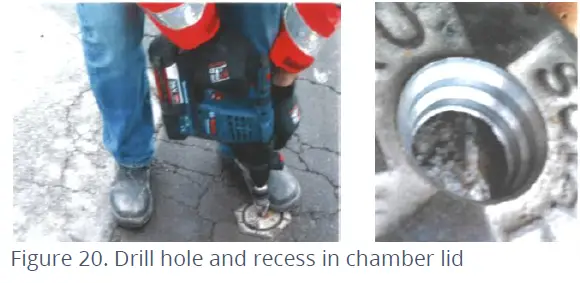 Thread antenna cable through hole, washer, and nut.
Thread antenna cable through hole, washer, and nut.- Secure antenna to the lid using a washer and the supplied nut.
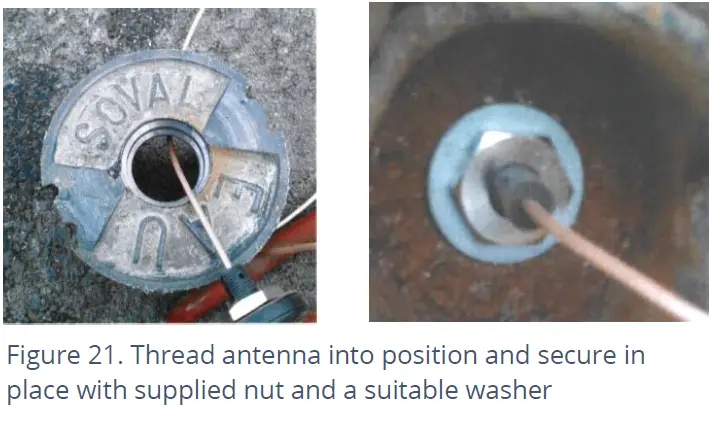
- If required, apply a resin epoxy such as Marine “Goop” to the perimeter of the antenna to help stabilize its position within the lid and to prevent water running onto the antenna cable. Do not cover the top of the antenna body as this may impair reception of satellite signals. Ensure all surfaces are clean and dry before applying the adhesive. Follow the adhesive manufacturer’s instructions.
- Ia mautinoa e le afaina le uaea antenna (fa'ata'ita'iga, i le tapuni) a'o fa'apipi'i ma fa'aoga.
Connect the GPS Antenna to the GPS antenna connector on the logger. Do not over-tighten. For a reliable connection, apply silicon grease and O-ring to the connector prior to fitting, as detailed in section 5.18. Ensure there are no sharp bends in the antenna cable.
A'o le'i tu'ua le nofoaga, fa'aoga le IDT e fai ai se su'ega GPS e fa'amaonia ai o lo'o lelei le nofoaga o le antenna ma o lo'o maua fa'ailoga satelite.
ATENNA (FESO'OGA CELLULAR)
An antenna should be selected to suit the available space in the chamber, allowing some space for it to be re-positioned (if required). Only use HWM-provided antenna with your logger, to ensure the radio interface meets approvals requirements (safety, etc). The Multilog 2 logger uses a metal “FME” style antenna connector.
A'o le'i fa'afeso'ota'i le antenna, ia fa'amautinoa e mago le so'oga ma mama mai le palapala ma otaota; o le susū po'o mea fa'aleagaina e mafai ona fa'aleagaina ai le fa'atinoga o le antenna. Faʻamama pe a manaʻomia.
Fa'aaogā le ga'o silicon SG M494 ile so'oga pe a mana'omia.
The antenna connector has an O-ring included for protection against water and moisture ingress; it acts as a seal. Check that the O-ring is present and undamaged.
Ensure that the connector and O-ring are dry and clear of dirt and debris. Clean carefully if necessary.
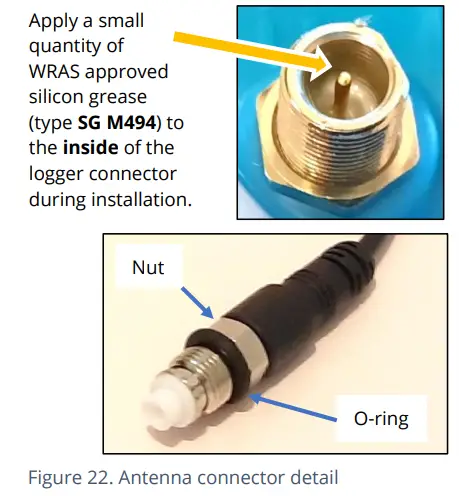
Insert the antenna connector into the logger connection and ensure it is fully home. Tighten the connector correctly; the nut on the antenna should be finger tight, plus 1/4 turn.
E le tatau ona i ai se pi'o ma'ai i pito uaea, po'o le ala o le uaea antenna.
Ina ia aloese mai le lamatiaga o le faaleagaina o le uaea antenna, siaki e leai se meafaigaluega e tuʻuina i luga. E fa'apena fo'i, o nonoa uaea o lo'o fa'amauina le uaea i le mea e tu'u ai e le tatau ona fufusi tele.
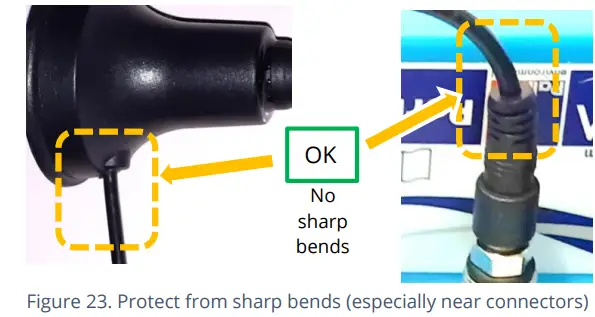
E le tatau ona punou le antenna ina ia fetaui ma le faʻapipiʻiina; afai e tele tele mo le potu, faʻaaoga se ituaiga laʻititi ole HWM faʻamaonia antenna.
When positioning the antenna, ensure that the radiating end of the antenna does not touch or go close to a metal surface.
O le elemene susulu o le antenna e tatau ona faʻatulagaina lelei i le ea saoloto (saoloto mai faʻalavelave).
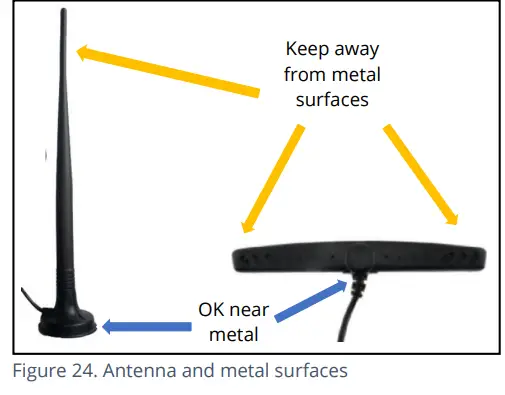
Taumafai e aloese mai le tu'uina o le antenna i se nofoaga e mafai ona lolovaia. Afai e le mafai ona alofia lenei mea, ona tuu lea i le mea e sili ona maualalo le lamatiaga.
Mo meafaigaluega e faʻapipiʻi i totonu o se potu i lalo ifo o le eleele, e tatau ona tuʻu le antenna i luga aʻe o le eleele pe a mafai. Afai e le mafai, tu'u latalata ile pito i luga ole potu.
E tatau ona fa'aoga le IDT e siaki ai e mafai e le logger ona fa'afeso'ota'i le feso'otaiga feavea'i ma o le antenna o lo'o i le tulaga sili ona lelei mo le nofoaga.
- Filifili se antenna talafeagai mo le faʻapipiʻiina ma filifili i lona tulaga muamua.
- Fua'i le tekinolosi feso'ota'iga o lo'o fa'aogaina ona fa'aoga lea o tapula'a lelei fa'ailo talafeagai (silasila ile fa'aoga-taiala ile IDT).
- Perform Network Signal tests (with the chamber lid closed) to confirm the logger connects to the mobile network and find the best location of the antenna. Re-position if required.
- Fa'atino su'ega telefoni e fa'amaonia ai e mafai e le logger ona feso'ota'i ma le DataGate server via the internet and (if required / available) SMS.
(O auiliiliga o le faʻaogaina o le IDT mo le faia o nei suʻega o loʻo tuʻuina atu i le IDT app user-guide).
Trouble-shoot a test-call failure if required, using the advice in the IDT app user-guide. Further information is given in the HWM Antenna Installation Guide (MAN-072-0001).
O nisi o fautuaga lautele o loʻo tuʻuina atu i lalo:
Monopole Antenna
Mo le tele o mea faʻapipiʻi, o le monopole antenna o le a maua ai le faʻatinoga talafeagai. Manatuga Fa'apipi'i:
- Ia usitaʻia i taimi uma soʻo se tapulaʻa faʻapipiʻi e tusa ai ma lapataiga o loʻo tuʻuina atu.
- O le antenna e iai se fa'avae maneta e fa'aoga mo le fa'atutuina.
Mo le faʻatinoga sili ona lelei, e manaʻomia e le antenna se "vaalele eleele" (mea uʻamea) i lona faʻavae. - Pe a faʻapipiʻi le antenna i totonu o potu tetele i lalo o le eleele e tatau ona tuʻu latalata i luga.
- Ia mautinoa o so'o se tapuni o potu e le fa'alavelave i le antenna po'o uaea pe a tatala/tapuni.
- This antenna is vertically polarized, it should always be installed in the vertical orientation.
- Aua ne'i punou le elemene fa'avevela o le antenna.
- E mafai fo'i ona fa'apipi'i le antenna i se fa'amau fa'apipi'i fa'apipi'i i se pou fa'ailoga o lo'o iai.
- Afai o lo'o fa'amauina se antenna e ni maneta, ia mautinoa o le mamafa o so'o se uaea e le mamafa tele le utaina o le maneta ina ia mafai ai ona tu'u ese mai le nofoaga fa'apipi'i.
- Aua ne'i fa'ataga so'o se meafaigaluega e tu i luga o le mea fa'apipi'i antenna ona e mafai ona fa'aleagaina le so'o po'o le uaea antenna.

Mo isi filifiliga antenna ma ta'iala fa'aopoopo fa'apipi'i, va'ai i pepa o lo'o maua ile lagolago webitulau: https://www.hwmglobal.com/antennas-support/
Fa'afitauli o le le manuia o le Su'ega Valaau
E tele mafua'aga e ono le manuia ai se su'ega Valaau.
E tatau ona siaki mea nei a'o le'i vala'au le lagolago a le HWM mo se fesoasoani:
| Fa'afitauli e ono tupu | Fofo |
| Network Busy due to excessive traffic. Commonly occurs around schools and at peak travel times. | Toe taumafai le suega pe a uma ni nai minute. |
| E le maua le faailo o feso'ota'iga i lou nofoaga. E le o masini Cell uma e ave fa'amatalaga fa'amatalaga | Relocate the logger to an area that has a data service or change to a different
network provider. |
| Network signal not strong enough.
For 2G and 3G networks, you need a CSQ (reported by the Call test) of at least 8 for reliable communications. For 4G networks, check the RSRP and RSRQ values are suitable, as described in the IDT user guide. |
Toe sii le antenna pe a mafai pe fa'ata'ita'i se isi fa'aputuga antenna. |
| E le sa'o le tulaga o le APN. | Check with your network operator that you have the correct settings for your SIM. |
Afai e fa'aauau pea ona e a'afia i fa'afitauli i feso'ota'iga, atonu e mana'omia lou siakiina o feso'otaiga feso'ota'iga i lou nofoaga.
FOFOGAIGA
So'o se fa'afitauli e tatau ona mafaufau i vaega uma o le faiga (IDT, le tagata fa'aoga, le logger, sensors, le telefoni feavea'i, ma le server).
Su'ega lautele:
O siaki muamua e faia ile asiasiga ile nofoaga e aofia ai:
- Check if the version of IDT you are using (IDT app for mobile devices / IDT for Windows PC) supports the features and sensors you are using; refer to section 8.
- Siaki o lo'o fa'aogaina le lomiga fou ole IDT.
- Siaki o le logger o loʻo faʻaaogaina o loʻo i ai le polokalama sili ona lata mai (IDT o le a ofoina atu e faʻaleleia pe a manaʻomia).
- Siaki le maa voltage lelei le logger (fa'aoga le Su'ega Meafaigaluega IDT).
- Siaki le uaea ma fesoʻotaʻiga i le va o masini ma le logger o loʻo i se tulaga lelei, e leai se faʻaleagaina poʻo se vai.
E foliga mai e le mafai e le logger ona fesoʻotaʻi ma le IDT:
- Check the communications path from the IDT host device to the logger is complete.(See section 2.8.)
- If using the direct cable connection method with IDT (PC), the logger may have shut down the connection to IDT due to is not being used for several minutes. Re-read the logger settings into IDT. Any previously unsaved settings will have been lost.
- If using the IDT app, the permission to use the cable may have expired. Detach the USB-A end of the programming cable and re-attach a few seconds later. Give permission to use the cable and then re-read the logger settings into IDT. Any previously unsaved settings will have been lost.
O faʻamatalaga mai le logger e le faʻaalia i luga o le 'auʻaunaga:
- Siaki tulaga mo le kata SIM e maua ai le fesoʻotaʻiga faʻamatalaga feaveaʻi.
- Ia mautinoa o lo'o fa'aogaina e le logger le nofoaga sa'o o fa'amaumauga URL ma le taulaga-numera mo lau server.
- Siaki taimi valaau i totonu ua uma ona seti.
- Siaki antenna o lo'o fa'apipi'i ma o lo'o i se tulaga lelei.
- Siaki le lelei o le faailo ma le malosi e fetaui lelei. Toe su'e le antenna, pe a mana'omia, pe taumafai se isi ituaiga antenna.
- Fai se Su'ega Valaau ma fa'amaonia OK.
- Ia mautinoa ua sa'o le fa'atulagaina o lau 'au'aunaga e maua ma tu'u atu fa'amaumauga.
TAUSIA, AUAUNAGA MA TOE LAVA
Unauthorized servicing will void the warranty and any potential liability for
HWM-Water Ltd.
FAAMAMAINA
Ia matau lapataiga saogalemu e faatatau i le faamamaina. E mafai ona fa'amama le iunite e fa'aaoga ai se vaifofo mama mama ma fa'asalalaugaamp ie malu. Taofi so'o i taimi uma ia leai ni palapala ma le susu.
FESOASOANI VAEGA
Antenna
Fa'aaoga na'o le antenna fautuaina ma saunia e le HWM.
Mo fa'amatalaga o filifiliga antenna ma vaega-numera e fa'atonu, va'ai i le so'oga lea: https://www.hwmglobal.com/antennas-support/ (or consult your HWM representative).
Ma'a
- Fa'aaoga na'o maa ma vaega o lo'o fautuaina ma saunia e le HWM.
- O ma'a e na'o se nofoaga autu o auaunaga ua faamaonia e le HWM po'o se tekinisia ua a'oa'oina talafeagai. Fa'afeso'ota'i lou sui HWM mo nisi fa'amatalaga pe a mana'omia.
- Batteries can be returned to HWM for disposal. To arrange the return, complete the on-line RMA (Returned Materials Authorisation) form: https://www.hwmglobal.com/hwm-rma/
- Va'ai ile Saogalemu Lapataiga ma Fa'amatalaga Fa'atagaga mo ta'iala o mea e mana'omia ile teuina.
SIM-card
- SIM-cards are replaceable by a HWM approved service center or relevantly trained technician.
- Fa'aaoga na'o vaega fa'aaoga e fautuaina ma saunia e le HWM.
FA'AFO'I O O'O'OGA MO AUAUNA PO'O LE FA'AVAE
A toe fa'afo'i oloa mo su'esu'ega pe toe fa'aleleia, ia mautinoa e mulimuli i fa'atonuga a lau tufatufaina e fa'amaumau pe aisea ua toe fa'afo'i mai ai le oloa ma tu'u mai fa'amatalaga fa'afeso'ota'i.
Afai e toe foʻi i le HWM, e mafai ona faia lenei mea e ala i le faʻatumu o le RMA i luga ole laiga: https://www.hwmglobal.com/hwm-rma/
A'o le'i fa'atauina, tu'u mea faigaluega ile faiga o Va'a (silasila ile fa'aoga-ta'iala ole IDT mo fa'atonuga). Va'ai ile Saogalemu Lapataiga ma Fa'amatalaga Fa'atagaga mo ta'iala o mea e mana'omia ile teuina.
Afai e palapala, ia mautinoa o loʻo faʻamamāina le iunite i se vaifofo mama mama ma pulumu vaivai, faʻamamago, ma faʻamago aʻo leʻi lafoina.
APPENDIX 1: SYSTEMS AND FEATURES REQUIRING IDT (PC)
Historically, setup of Multilog2 loggers was undertaken using the IDT (PC/Windows) tool. Setup of most Multilog2 logger functions for Pressure and Flow channels and the most commonly used alarm types has recently been introduced to the IDT (mobile app) tool. However, the IDT (mobile app) does not yet support some situations.
The following logger types require IDT (PC) for their entire setup:
- WL/*/*/* Multilog2 logger device (models for use in WITS systems). Refer to the IDT (PC) user-guide for most settings. Additional information for WL series models can be found in the following user-guide: MAN-147-0017 (Supplement for models supporting WITS protocol).
- RDL6*LF/* Multilog (original) logger devices.
The following logger/sensor combinations require IDT (PC) for setup:
- Multilog2 using a SonicSens2 sensor.
- Multilog2 using a SonicSens3 sensor.
- Multilog2 using a RS485/MODBUS sensor.
- Multilog2 using an SDI-12 sensor.
- Multilog2 using a Hydrophone or LNS (Leak-Noise Sensor).
- Multilog2 using a GPS Satellite (for either location or Time-sync).
The following logger features require IDT (PC) for setup:
- Update of firmware of logger or attached sensors.
- Fast logging features (Pressure Transient, Enhanced Network logging).
- Flow Rate (when calculated from flow velocity, channel depth, channel geometry).
- Profile Alalaga.
- Tamper Alalaga.
- GPS functions, including GeoFence Alarm.
APPENDIX 2: COMMUNICATING TO LOGGER VIA SMS
Fa'aaliga: This facility may not be available on your logger, depending on the SIM card fitted. Some SIM cards or networks or service providers do not have SMS messaging available. (See also section 1.4).
- Applying a ‘Modem Activation Key’ (See Figure 25) to the 10-pin Comms interface for a period of 10 seconds will activate the logger’s cellular communications modem for a period of 5 minutes. This will allow an installer to send SMS (text) messages from a mobile phone and for the logger to respond.
(There is an alternative way to do this using IDT). - Tapuni le potu po'o le kapeneta ina ia i ai mea uma i lona tulaga mulimuli.
- Using a standard mobile phone, send a text message to the SMS number of the logger (check the logger label), including the international dialing code if needed.
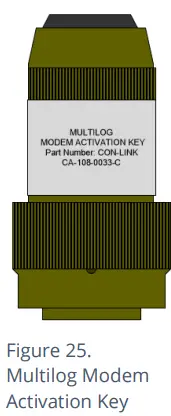
- E tatau ona faitau le feau tusitusia TTTT#
A maeʻa ni nai sekone / minute (faʻalagolago i le fesoʻotaʻiga fesoʻotaʻiga) o le a toe tuʻuina atu e le logger se feʻau ia te oe ma faʻamatalaga o lona tulaga o iai nei.
- Example tali mai se logger:
TTTT138-002 V01.70CSQ:1010.9VyouridRT hh:mm ss dd-mm-yy …
Ina ia fa'amalamalama le fe'au na toe fa'afo'i mai, fa'amolemole va'ai le laulau o lo'o i lalo:
| Savali | Fa'amatalaga |
| TTTT | Original command text without # |
| 138-002 | Logger type number |
| V01.00 | Firmware version in Logger. |
| CSQ: nn | Signal strength nn (nn = 6 to 30) |
| 10.9V | Faʻagaioiga voltage |
| yourid | Your Logger ID |
| RT hh:mm ss dd-mm-yy | Real Time Clock setting |
| ST hh:mm ss dd-mm-yy | First Time the logger was started |
| LR hh:mm ss dd-mm-yy | Last Time the logger was re-started |
| Ch1 (A) 0029.0 | Channel 1 29.0 units |
| Ch2 (A) 0002.2 | Channel 2 2.2 pulses/sec |
If the CSQ: value in the message is OK, then the installation is complete. The logger will automatically go back to sleep after 10 minutes.
E mafai ona tuai i le fesoʻotaʻiga SMS, o le tali atu i lau feʻau atonu e le vave. Afai e leai sau tali i le 10 minute, toe tatala le potu ma faʻaaoga le modem diagnostic lafo oe lava SMS suʻega. Afai e o'o mai lenei mea, ona fa'aleleia lea o le nofoaga o le antenna ma toe taumafai.
Fa'aaliga: Some Roaming SIM cards do not accept incoming text messages.
Check with your service provider if you are unsure.
- Faiga Fa'asao Suavai 1960 Old Gatesburg Road Suite 150
- Kolisi a le Setete PA, 16803 800-531-5465
- www.fluidconservation.com
FAQ
Q: Where can I find additional support for Multilog 2?
A: For further assistance not covered in the manual, contact the HWM Technical Support team at +44 (0) 1633 489479 or email cservice@hwm-water.com.
Pepa / Punaoa
 |
FCS Multilog2 Multi Channel Data Logger [pdf] Tusi Taiala ML- - -, PT- - -, EL- - -, Multilog2 Multi Channel Data Logger, Multilog2, Multi Channel Data Logger, Data Logger, Logger |
